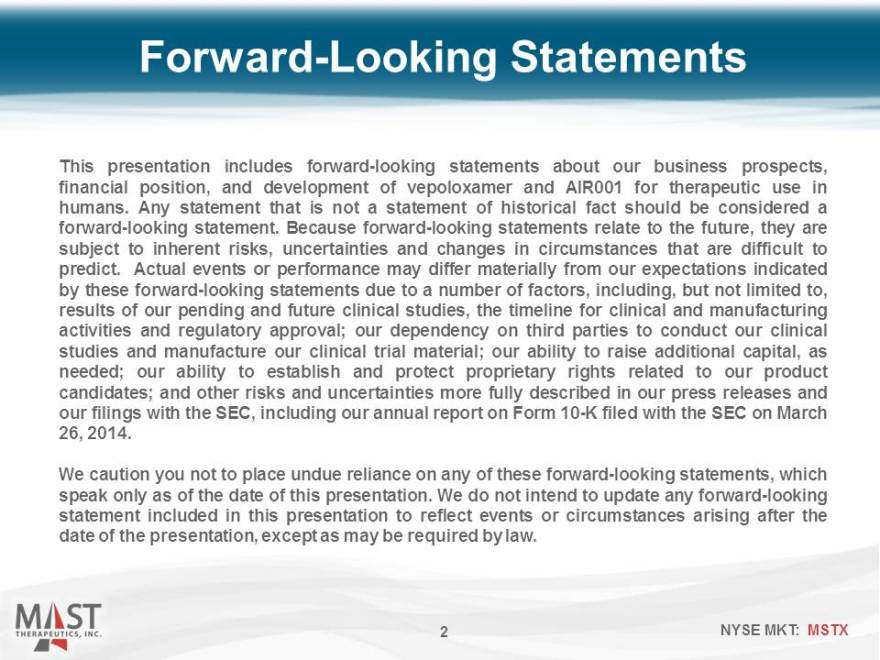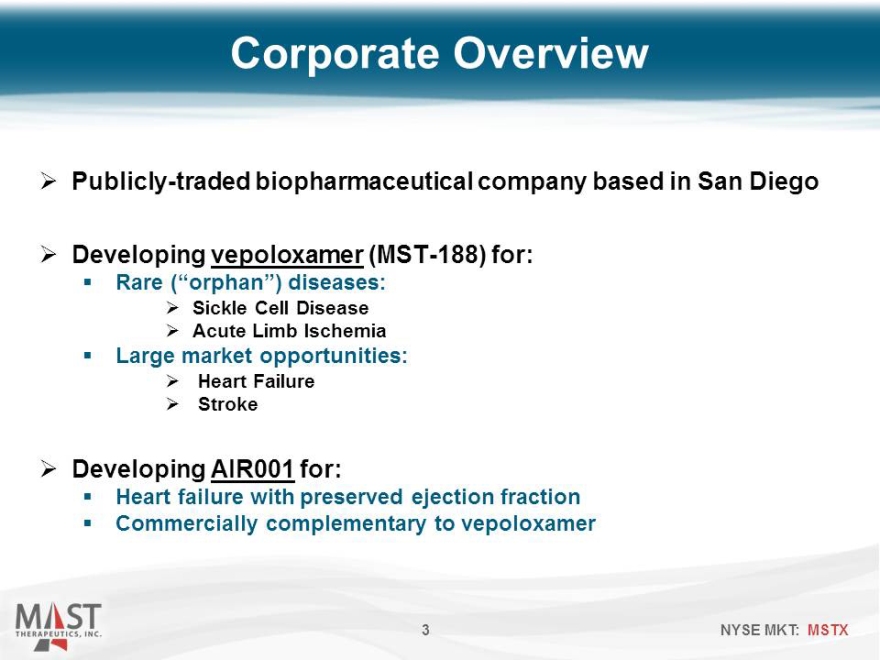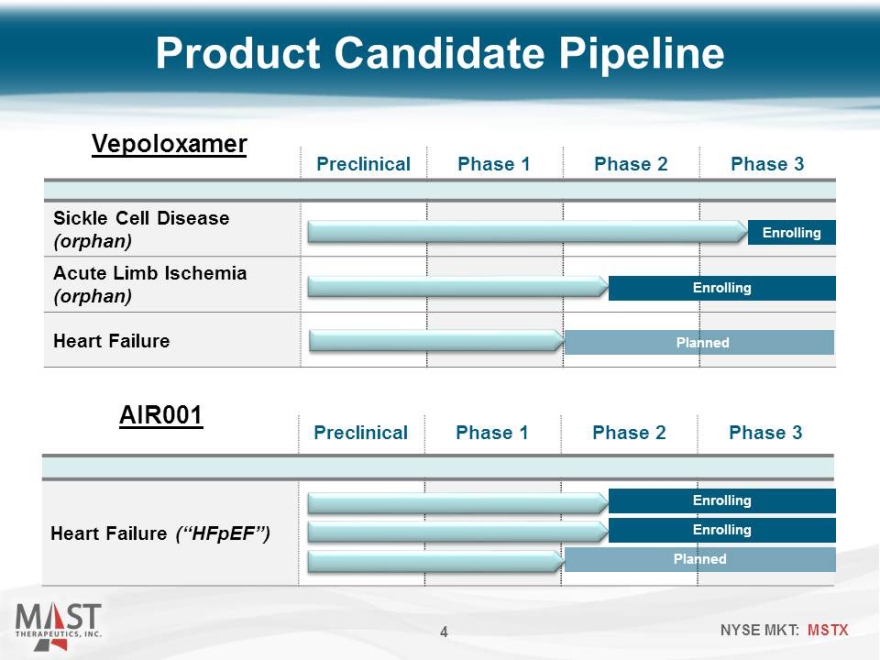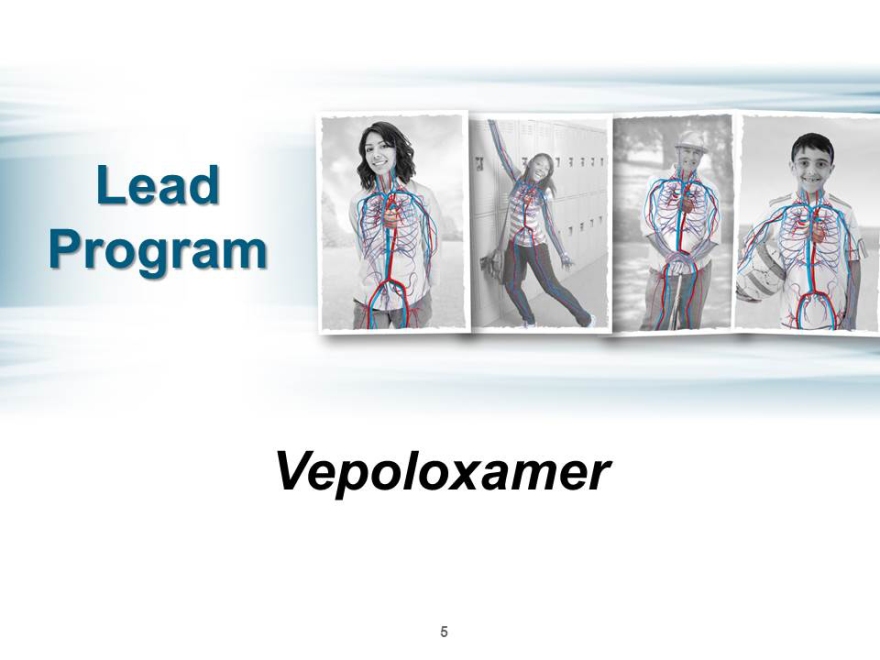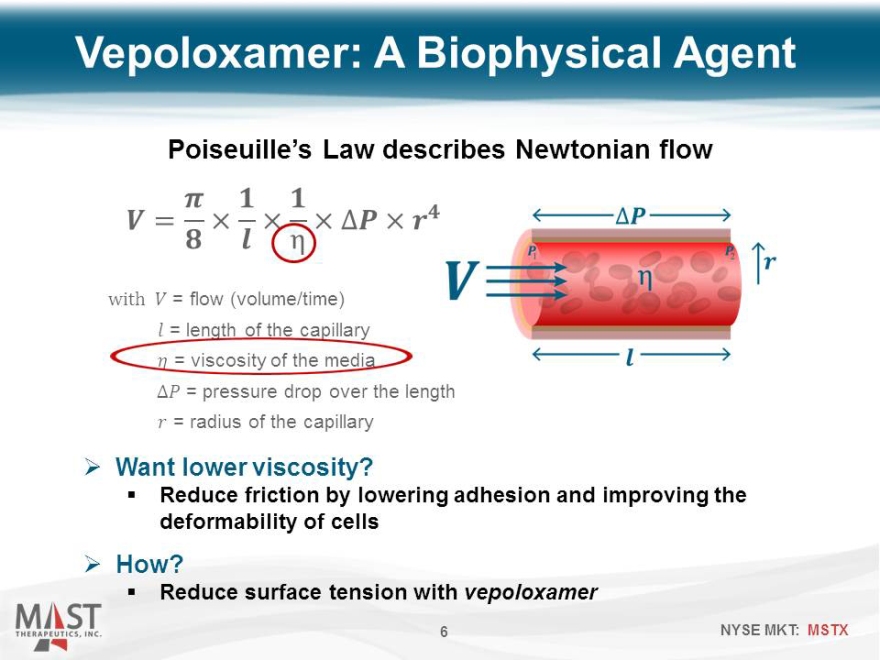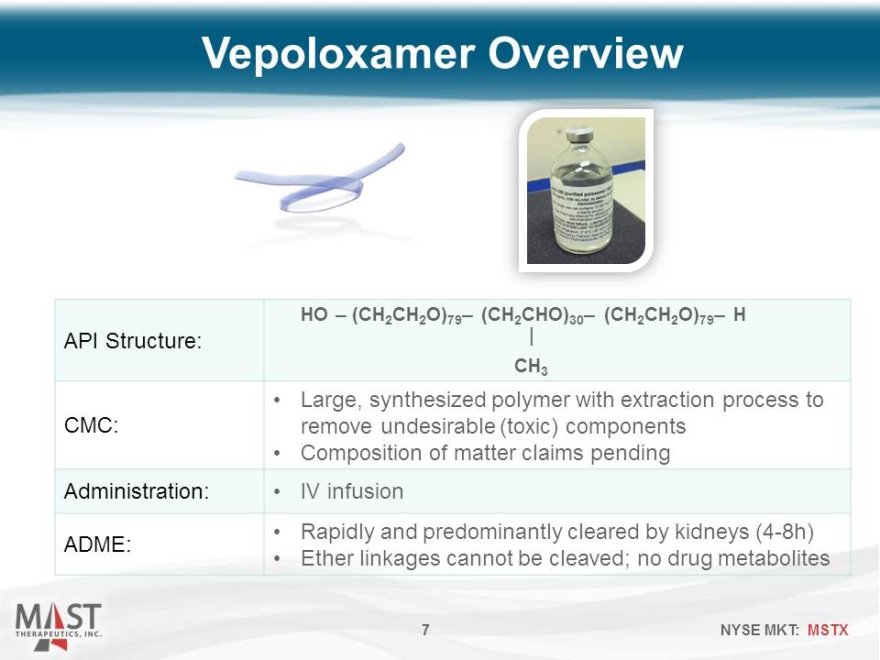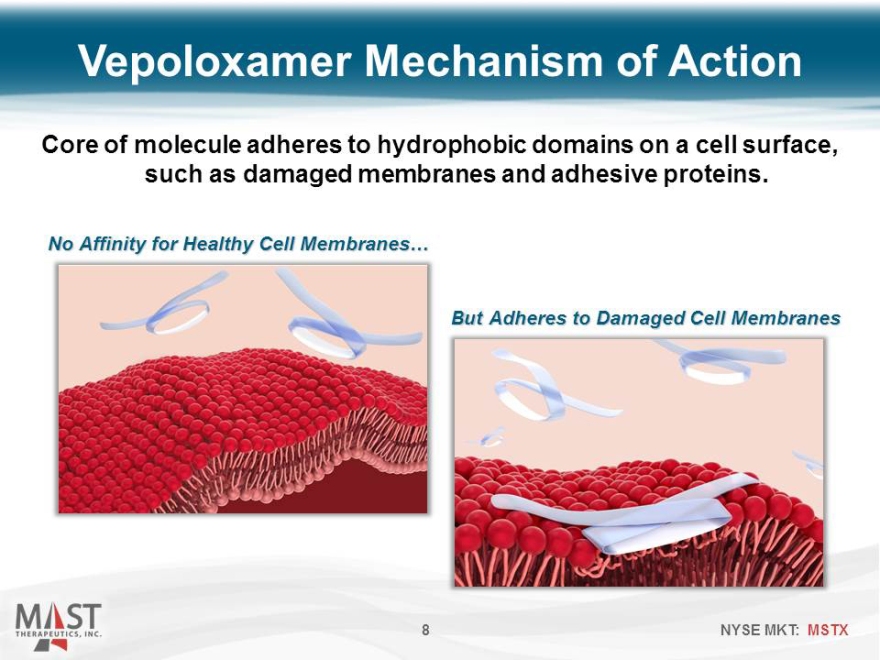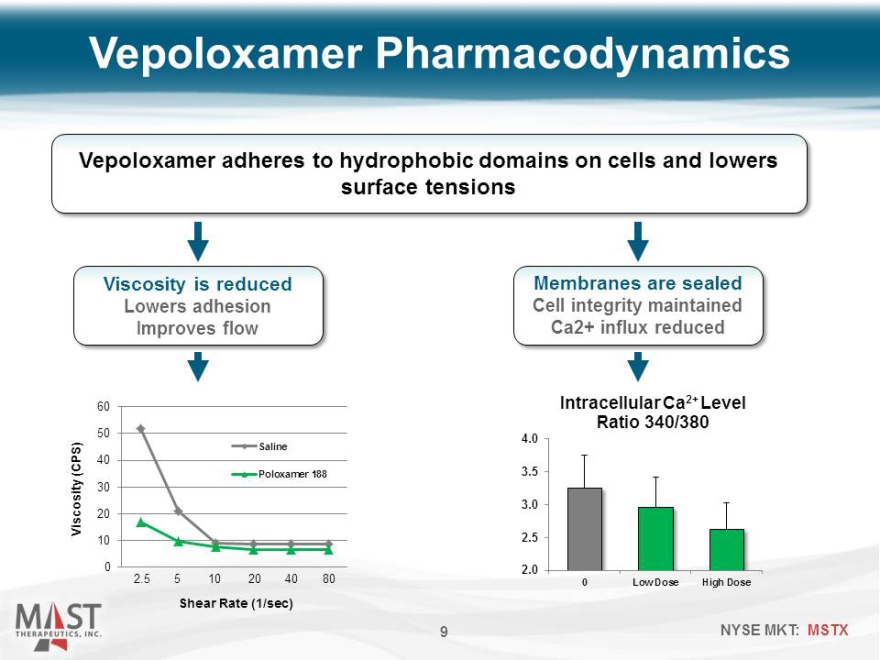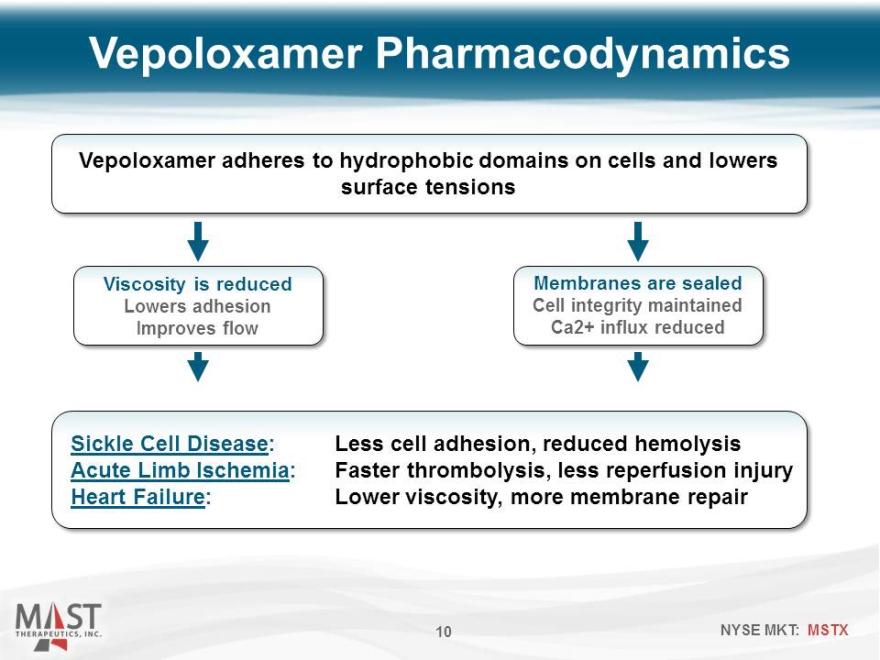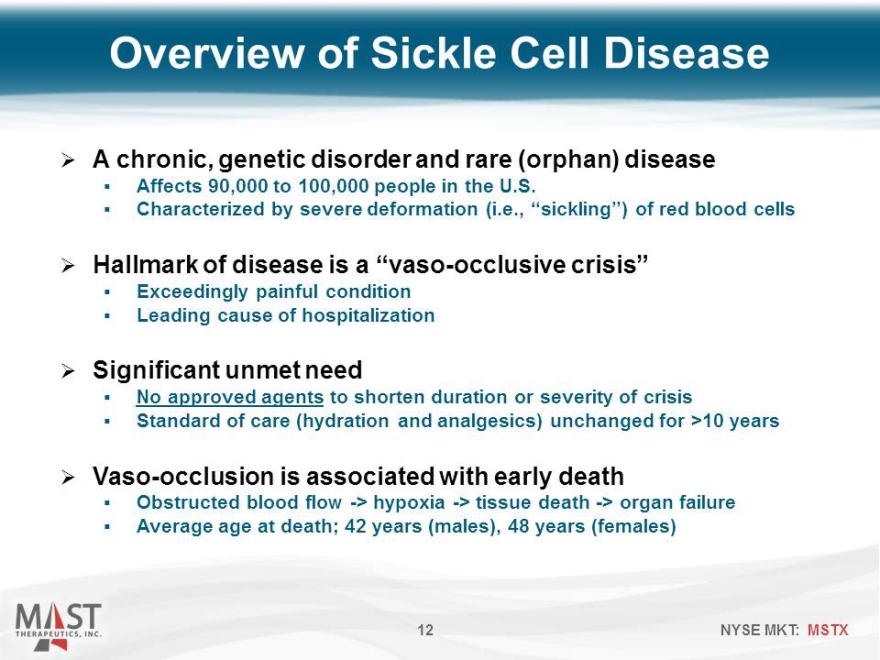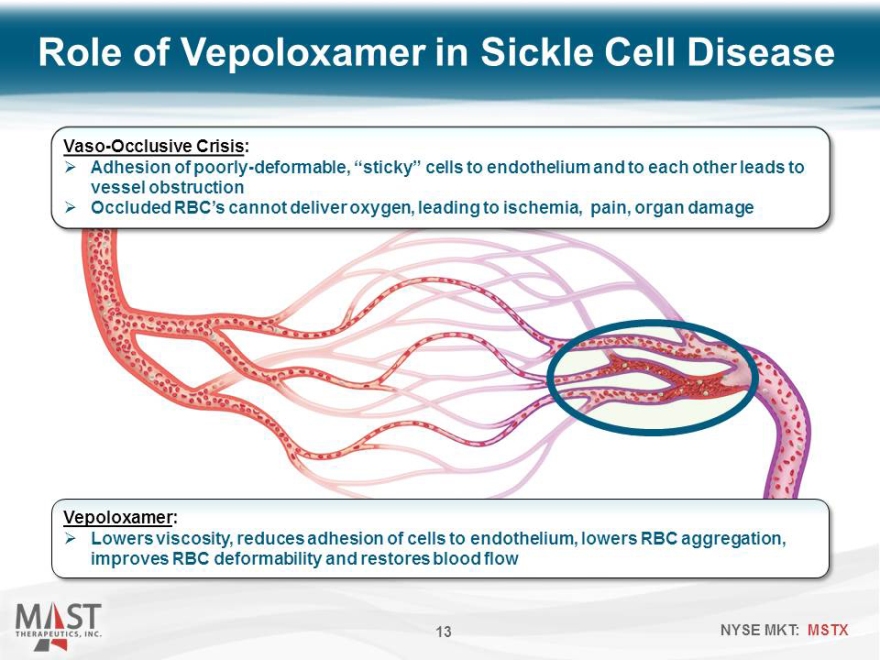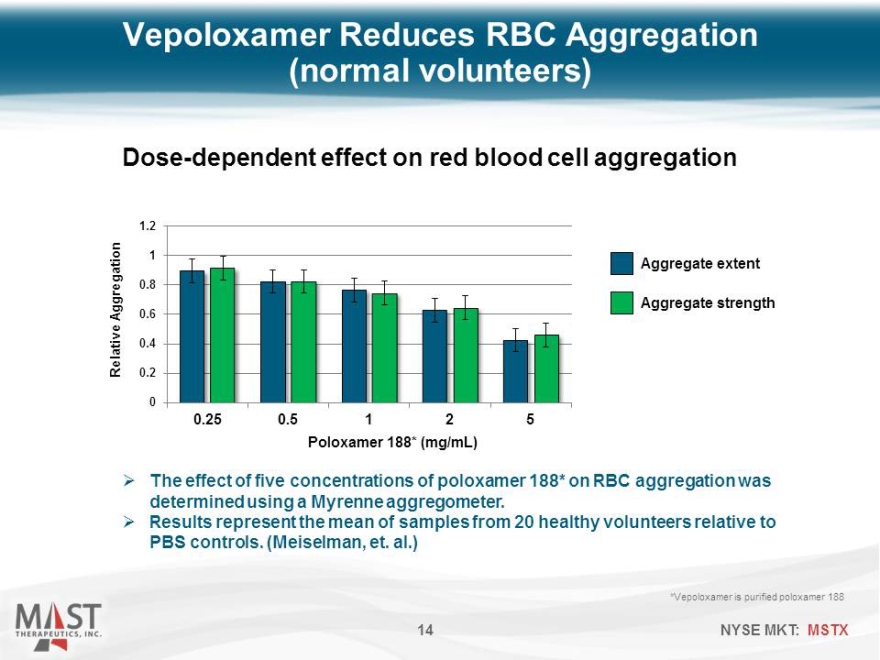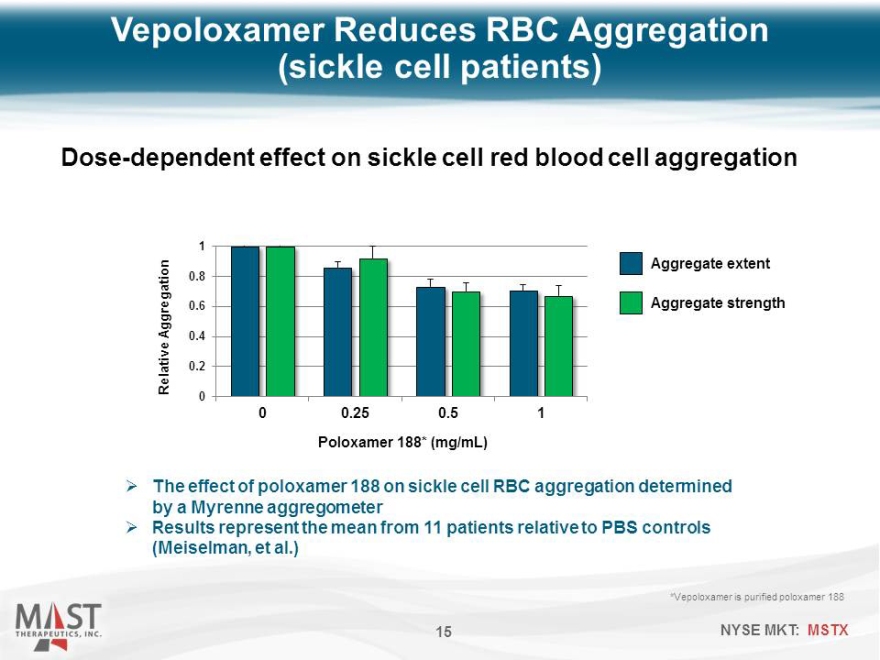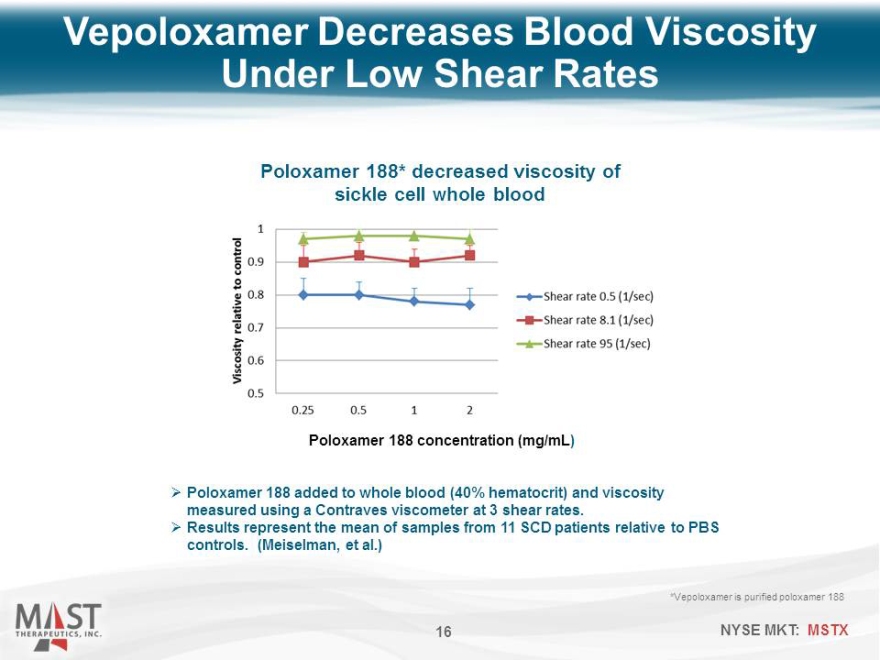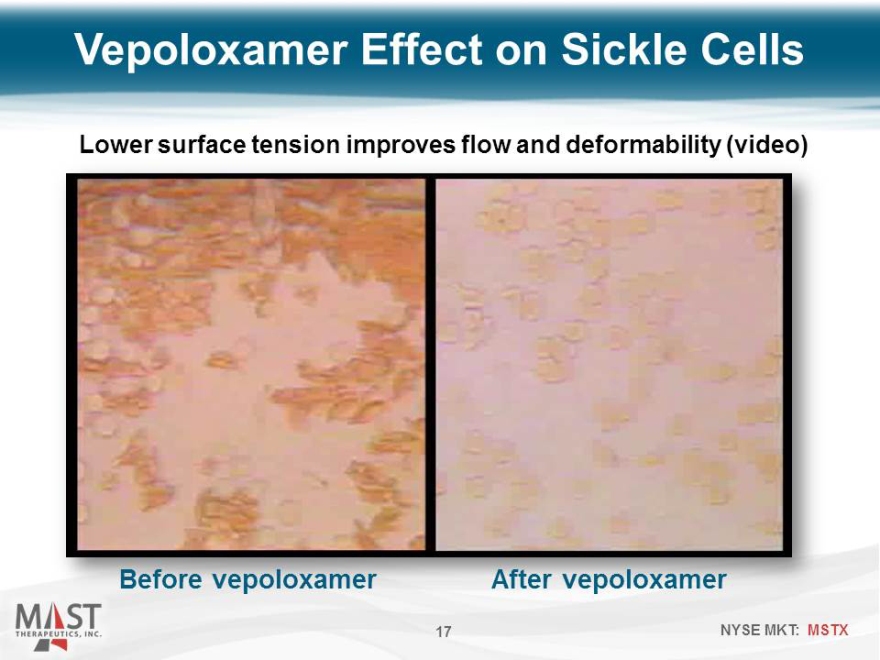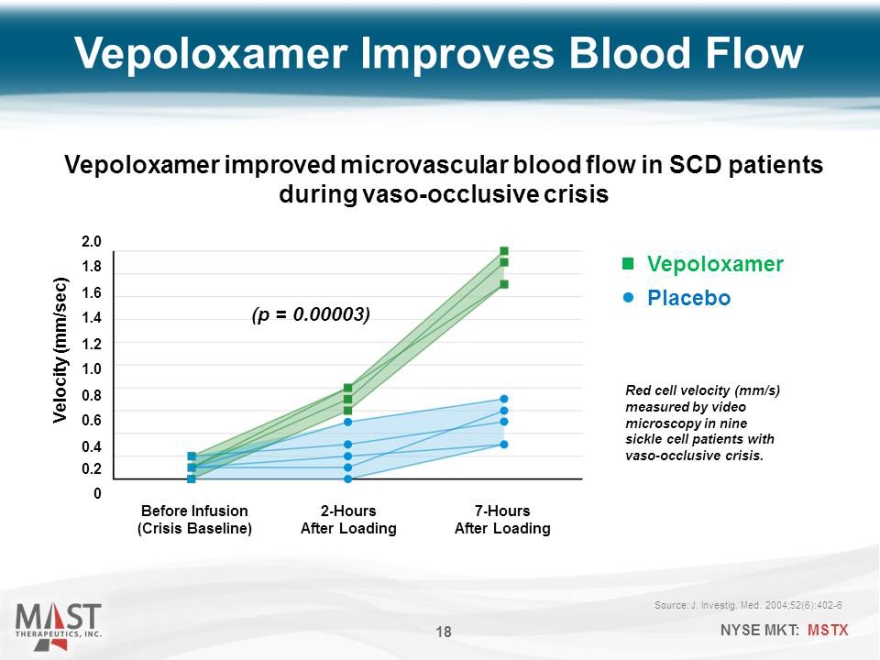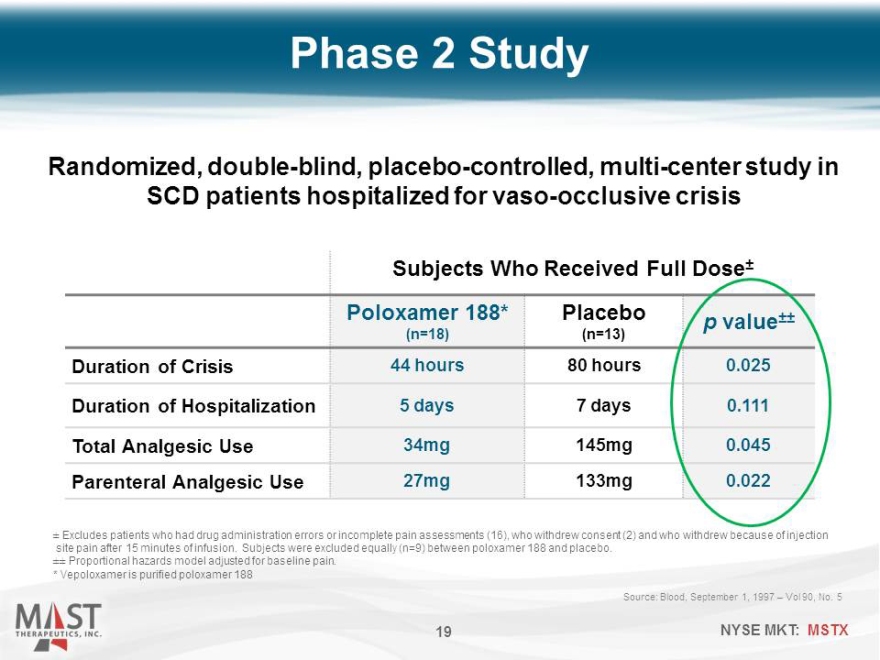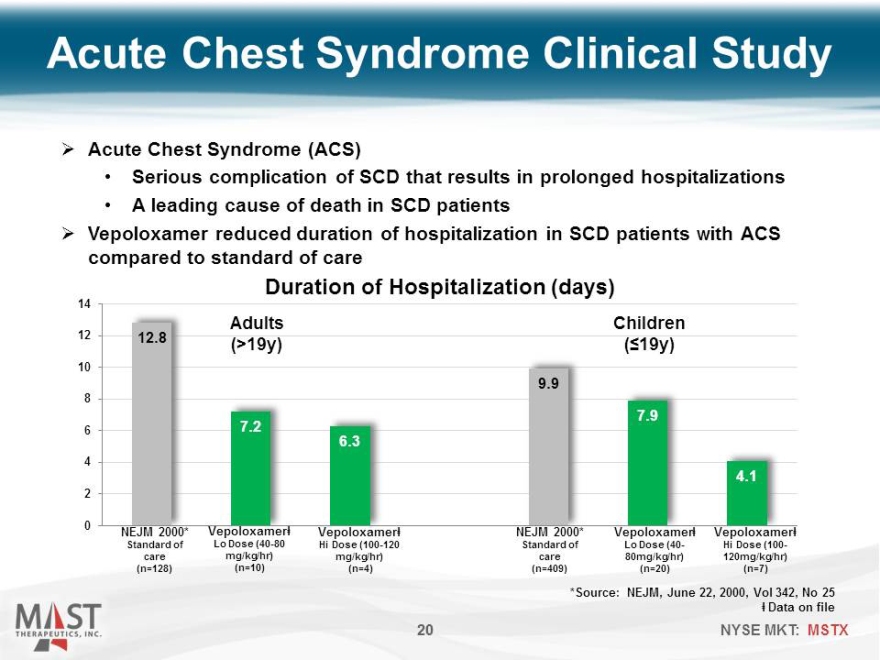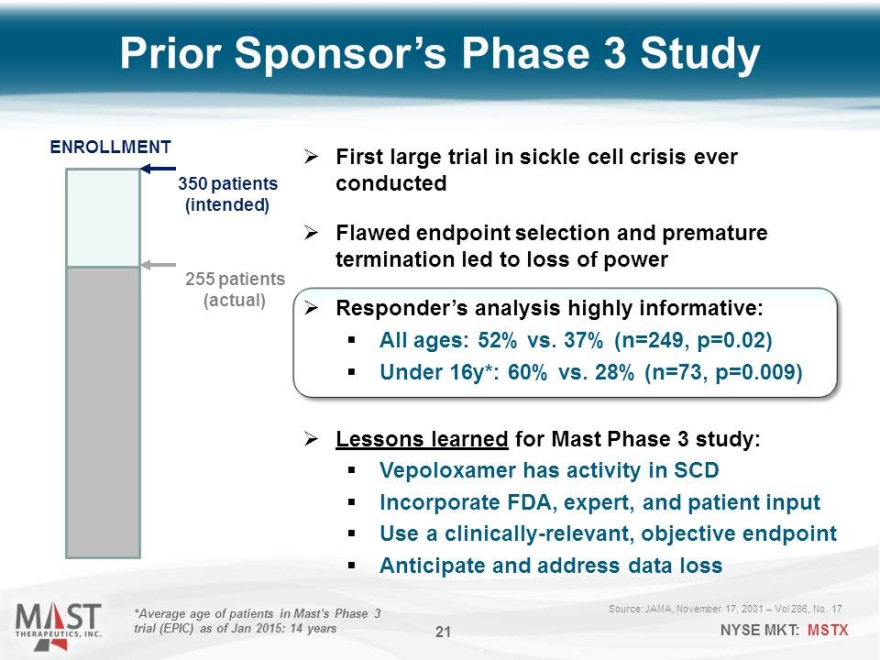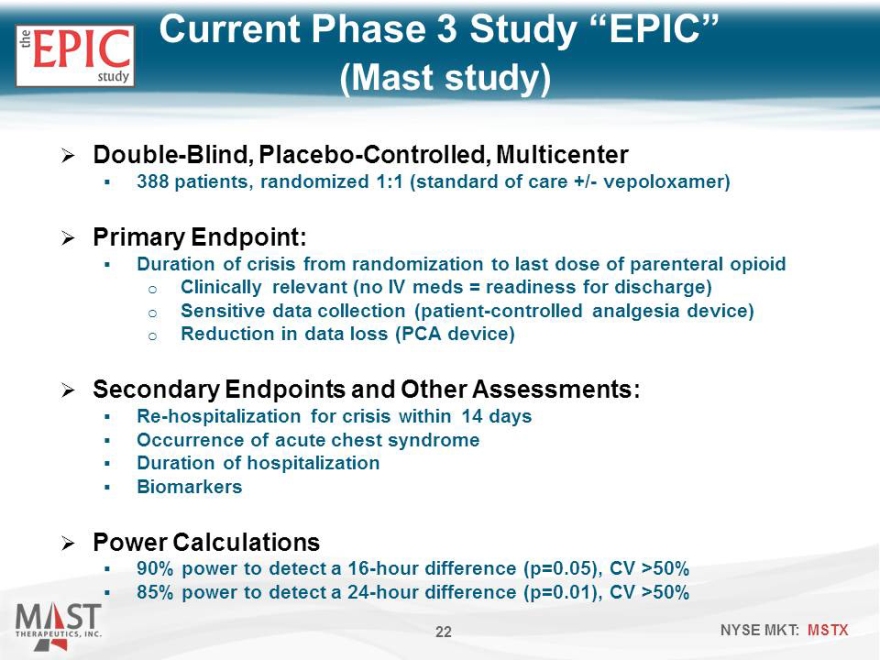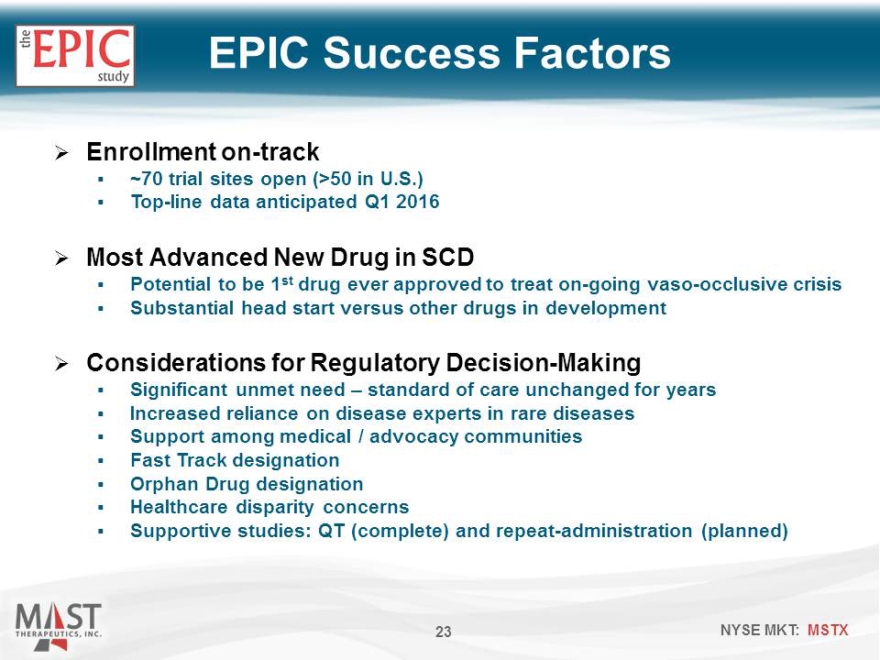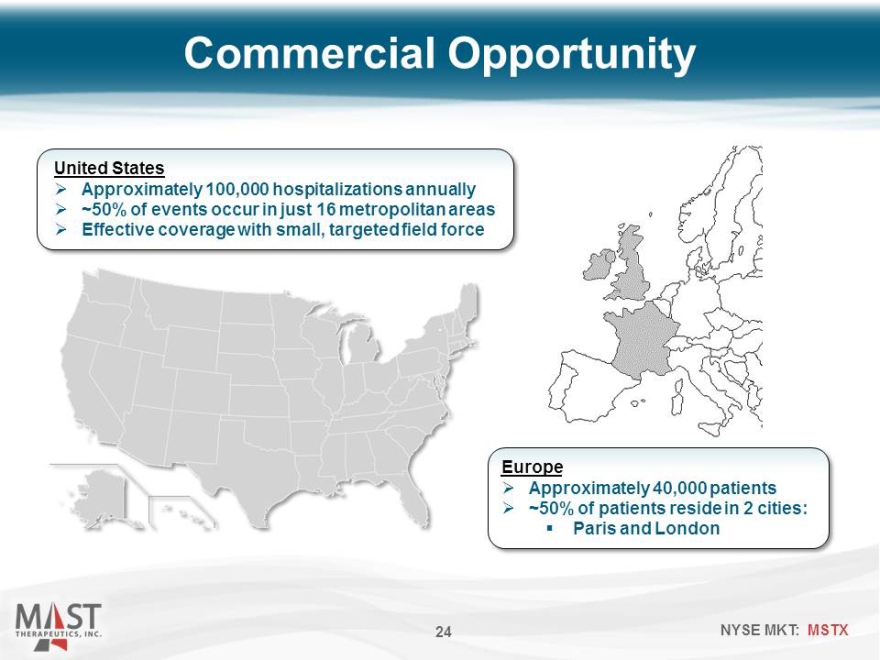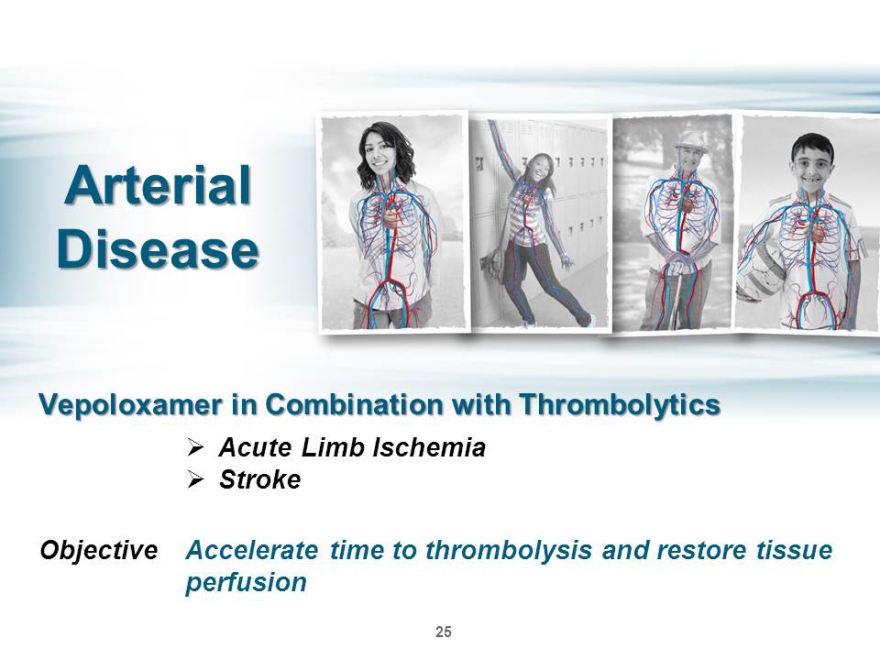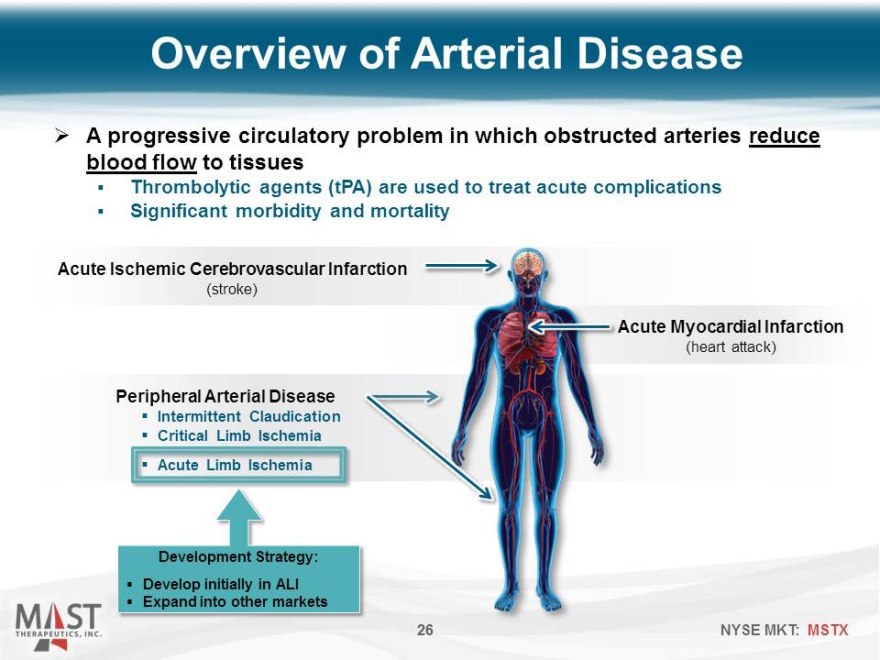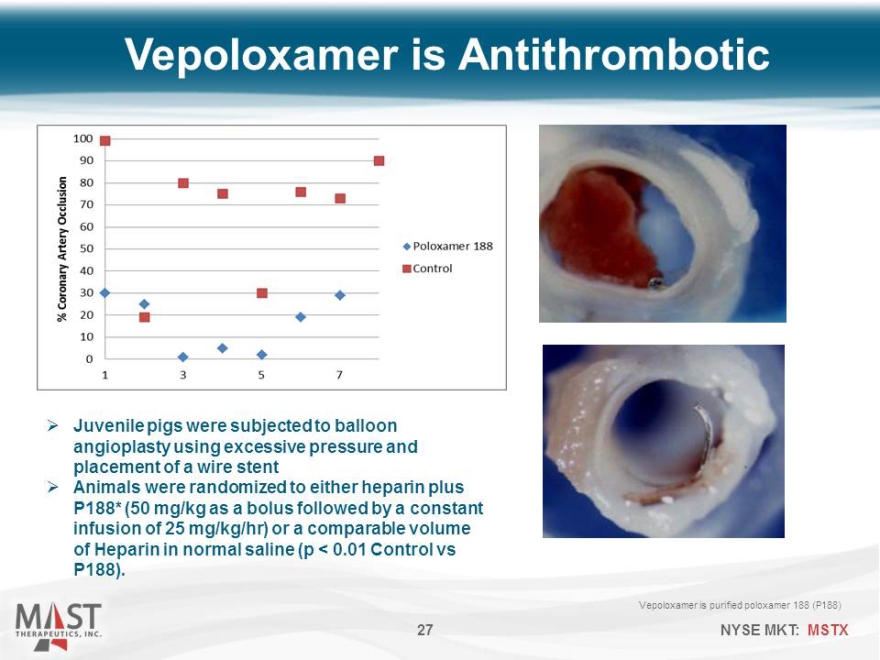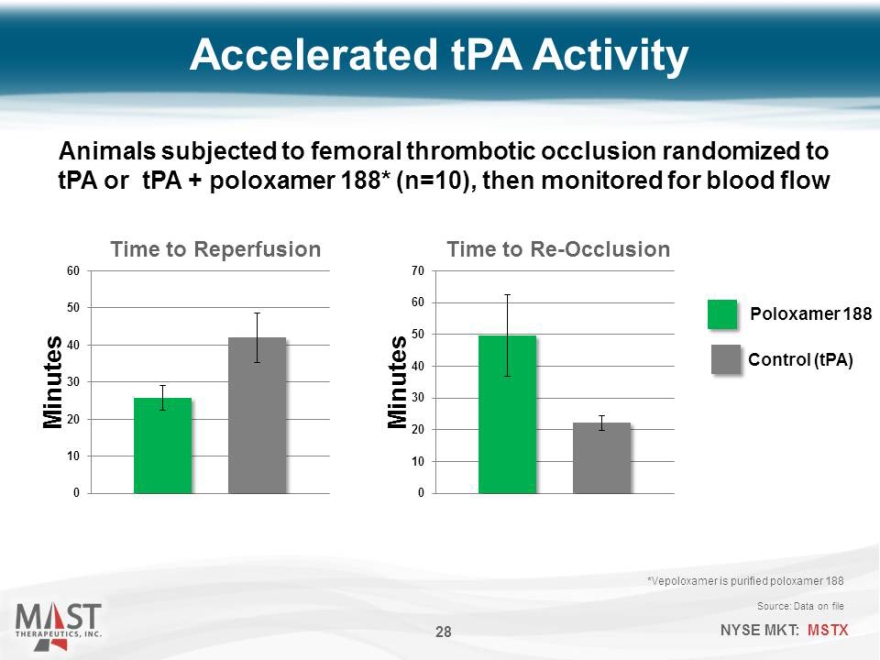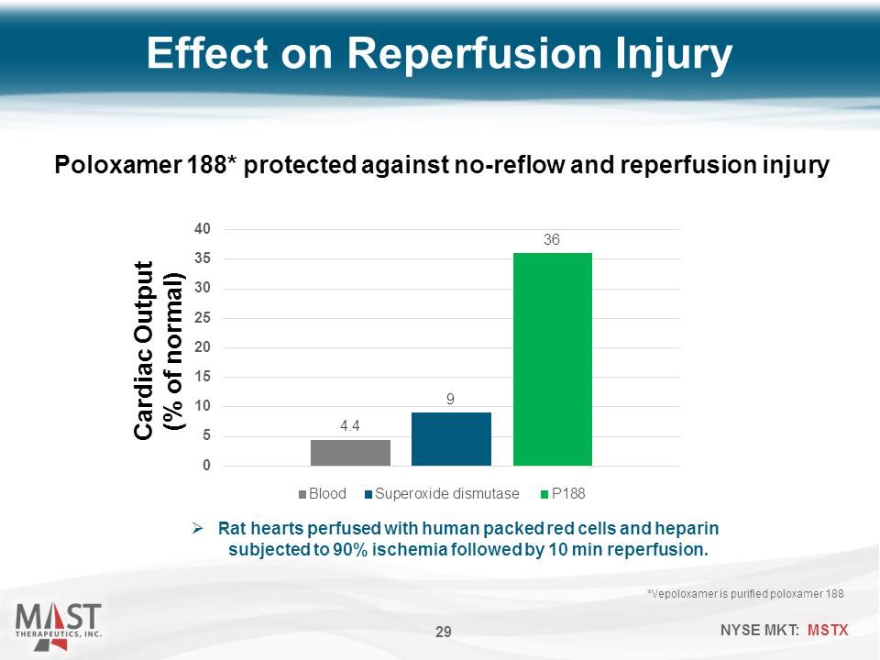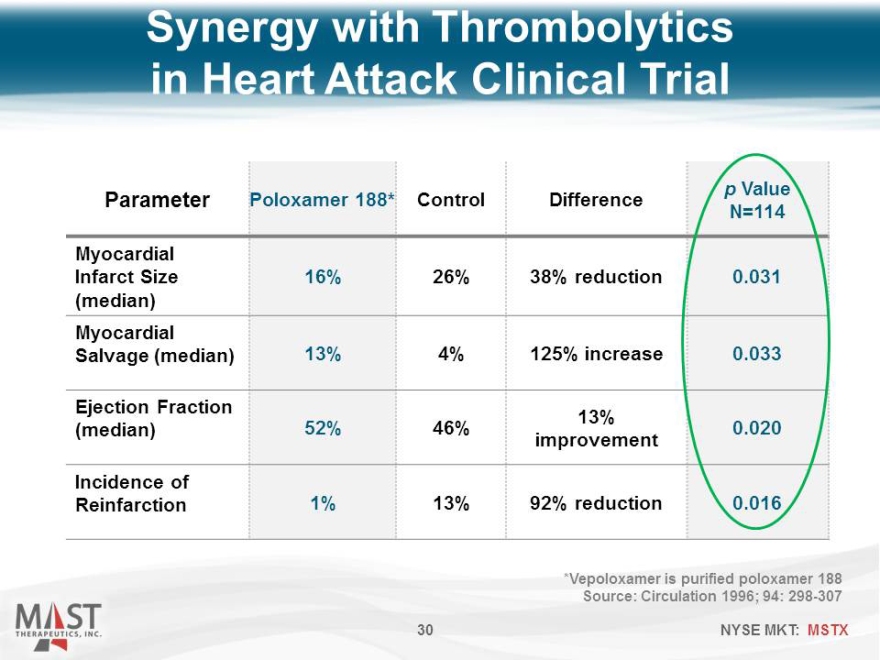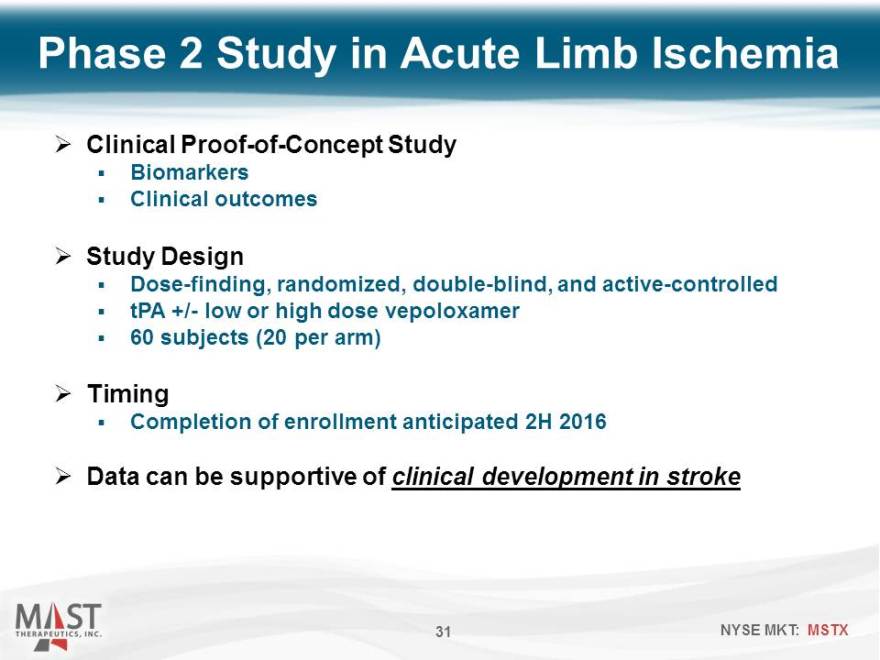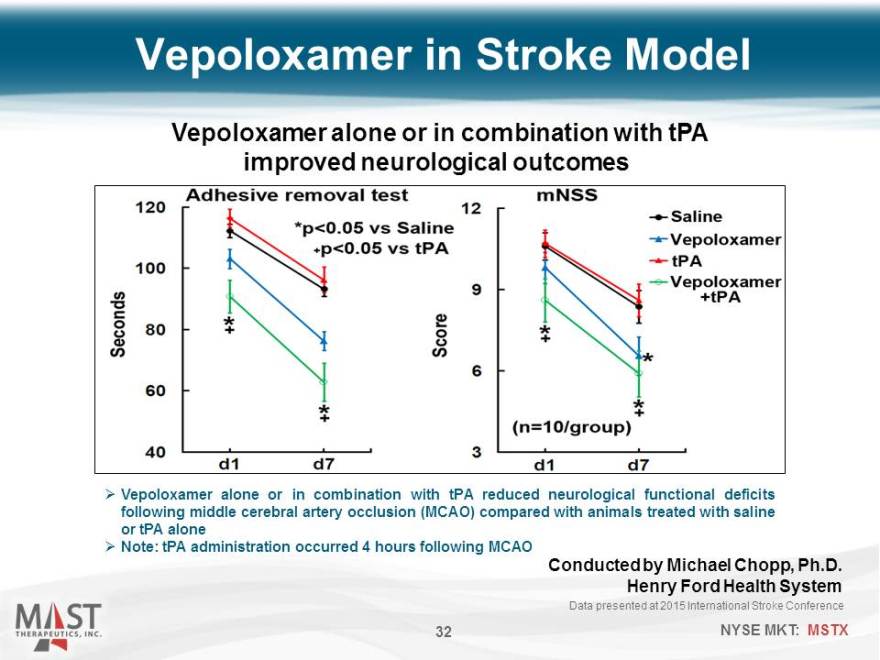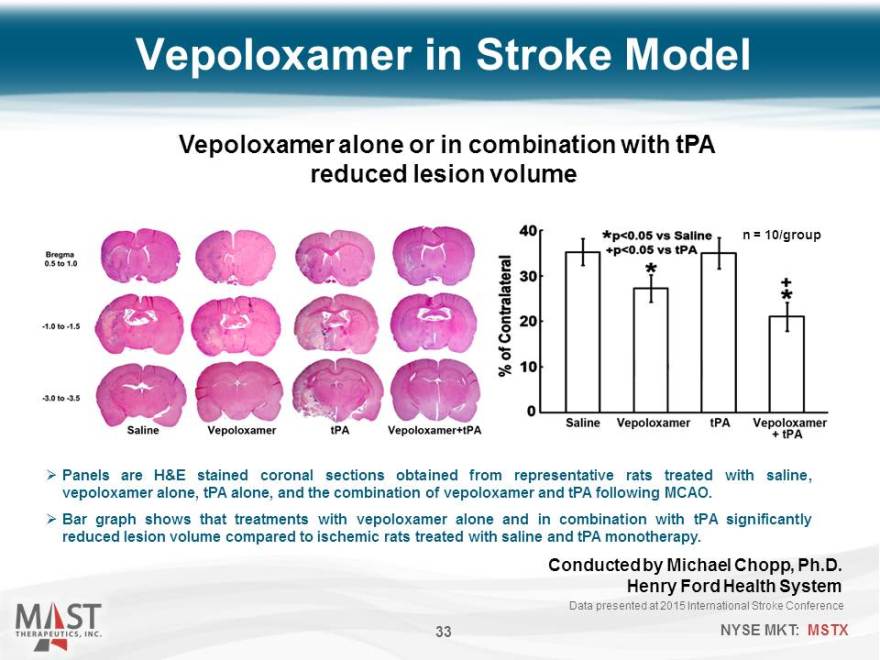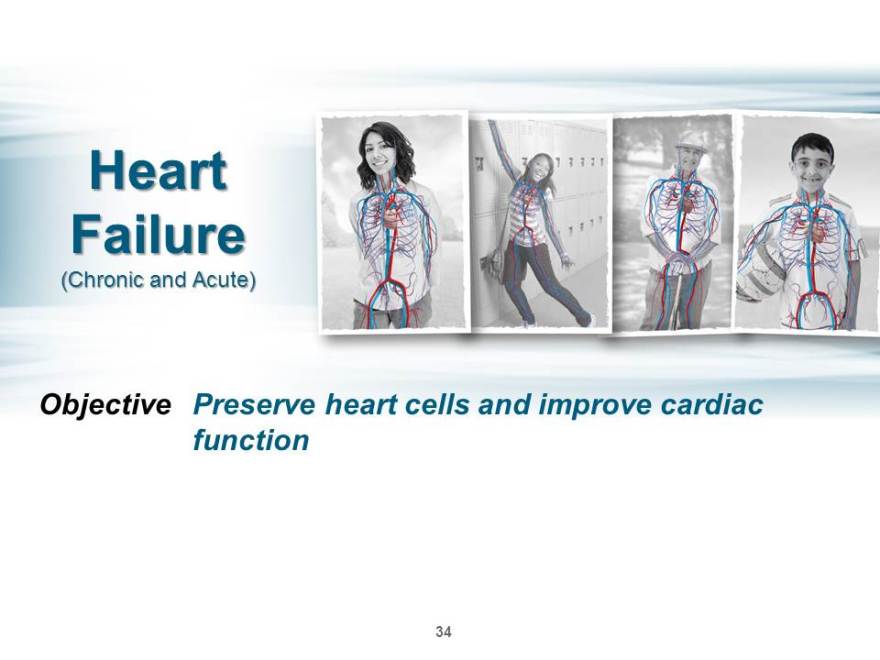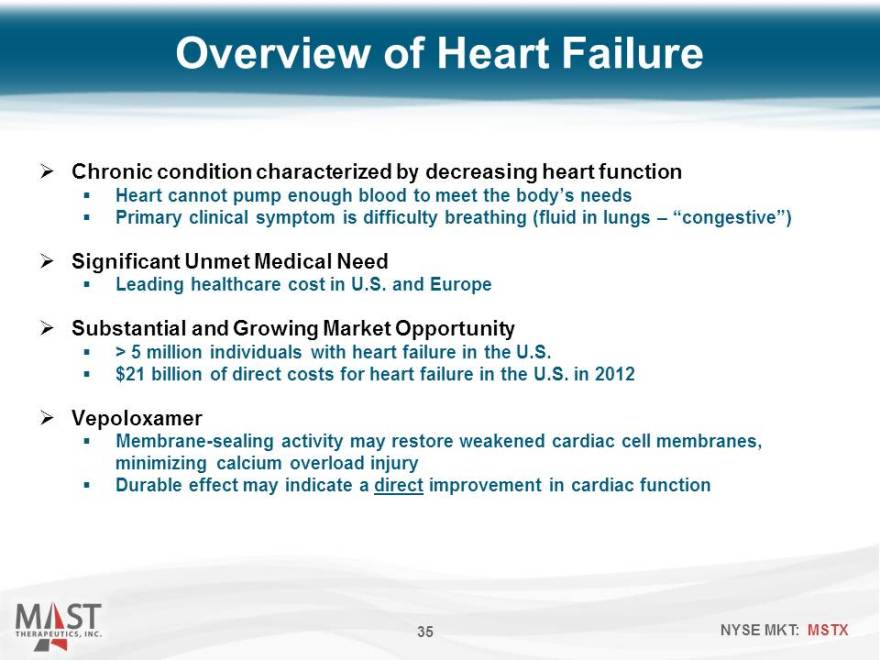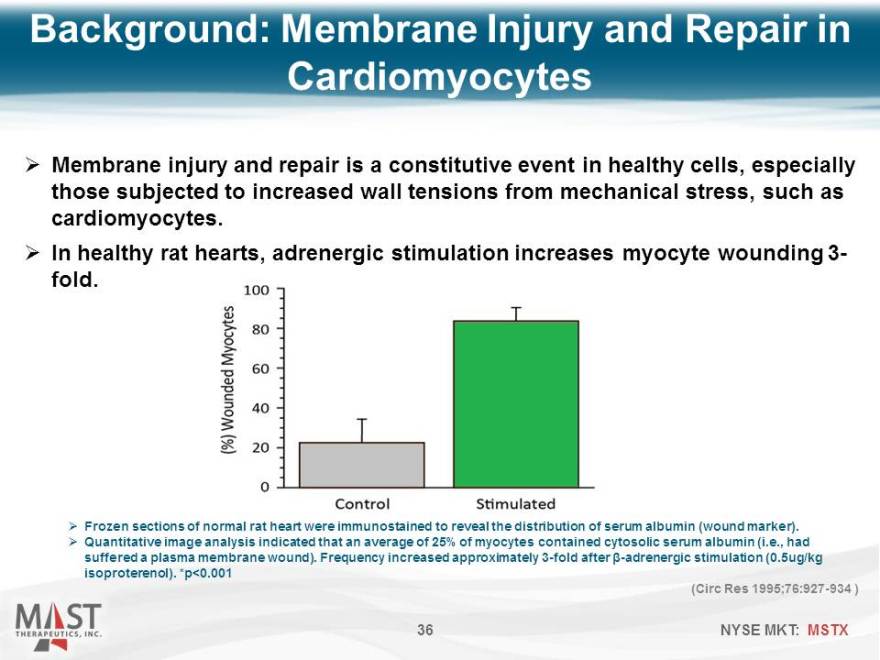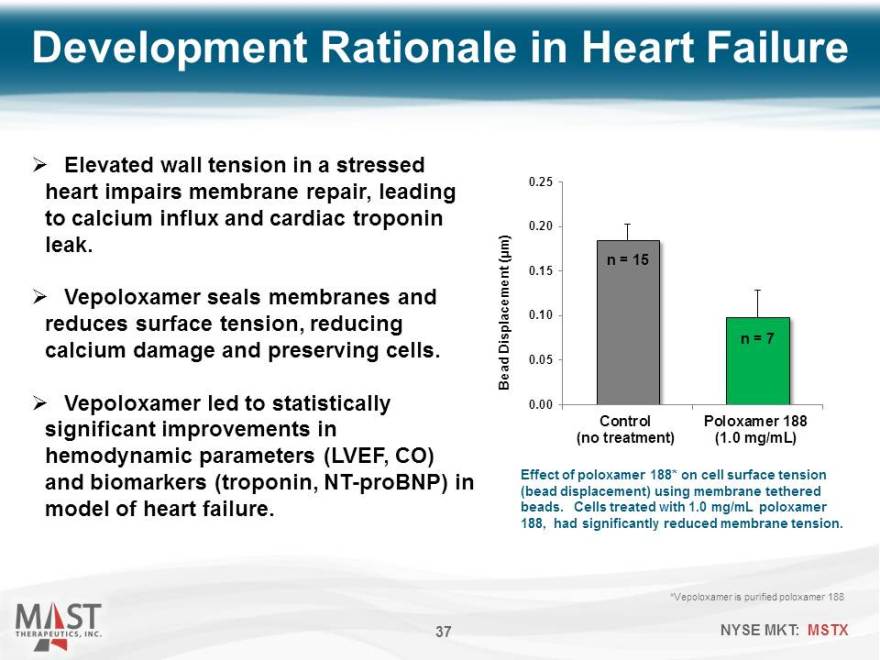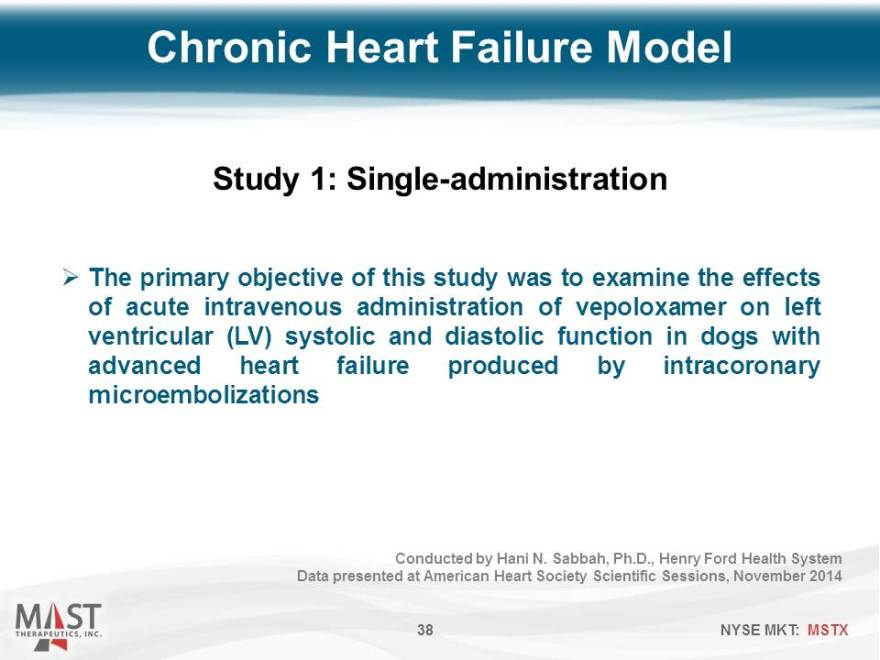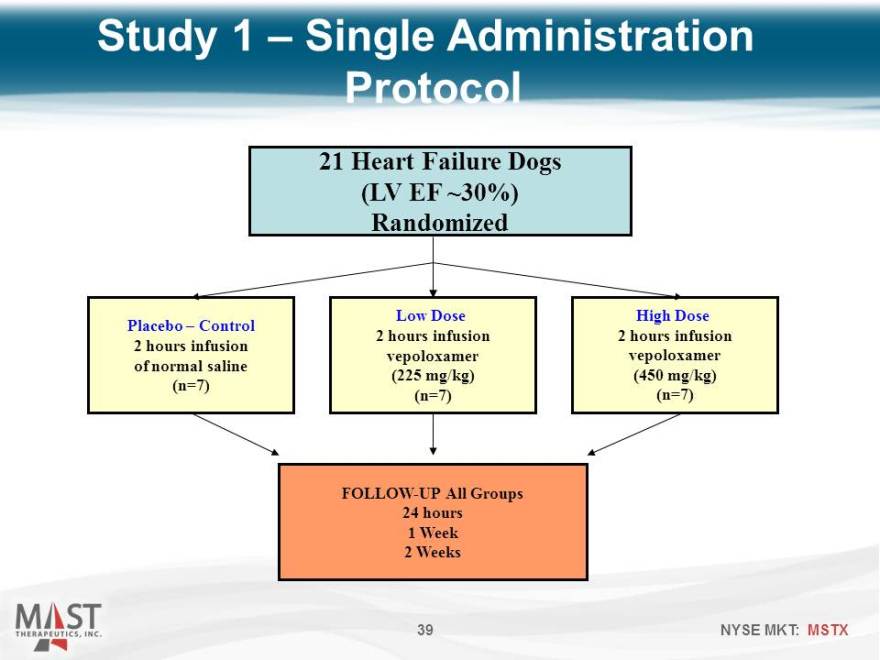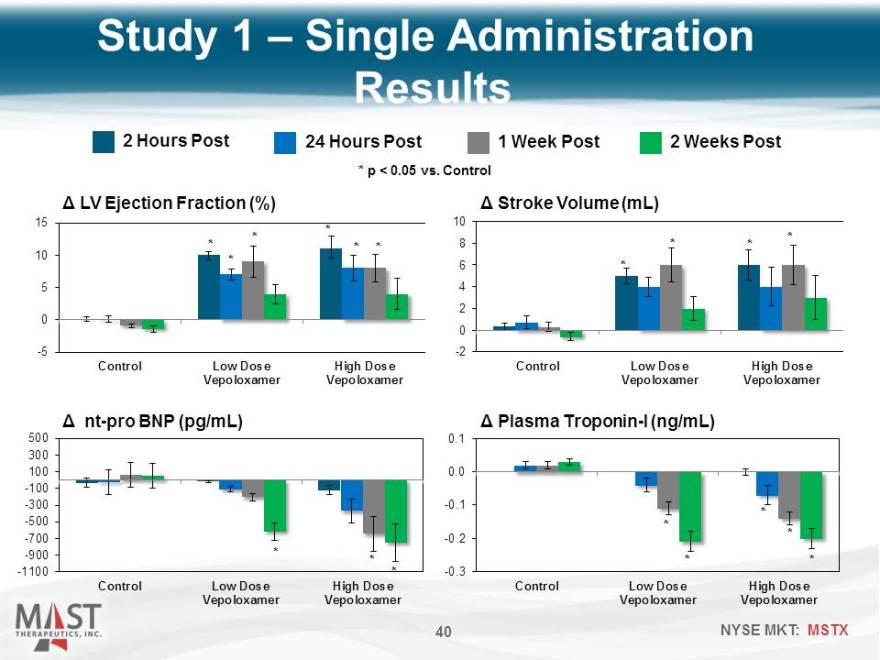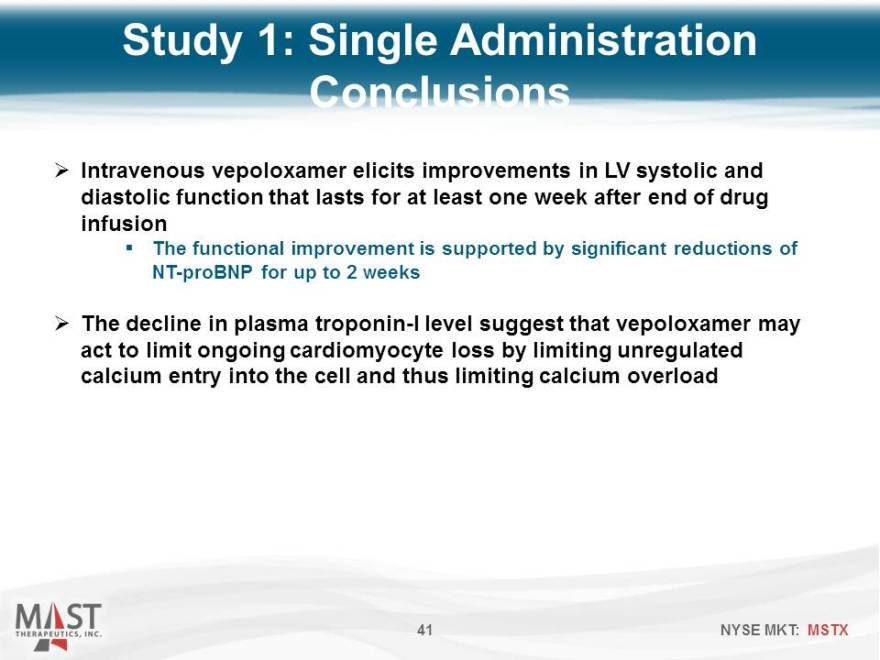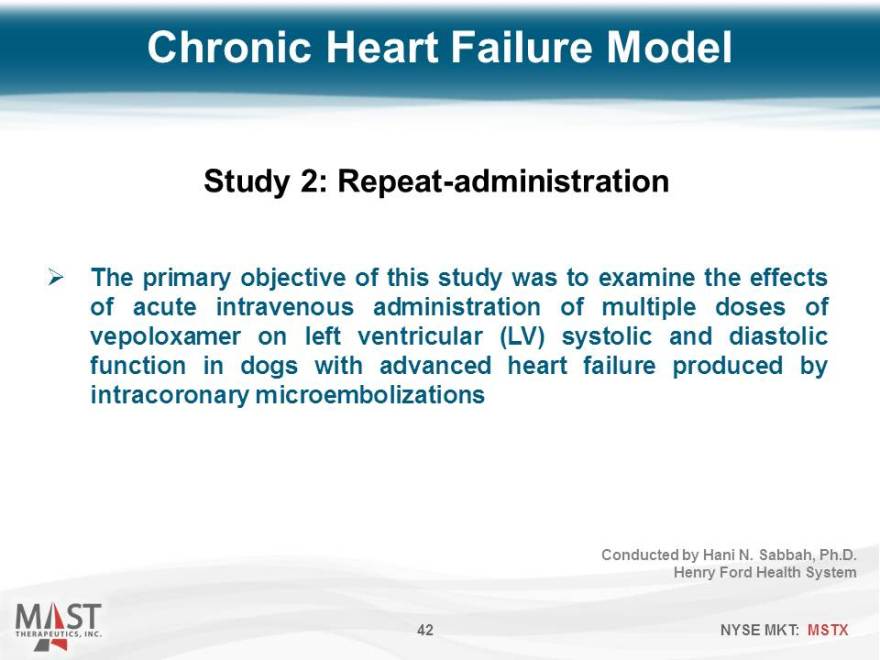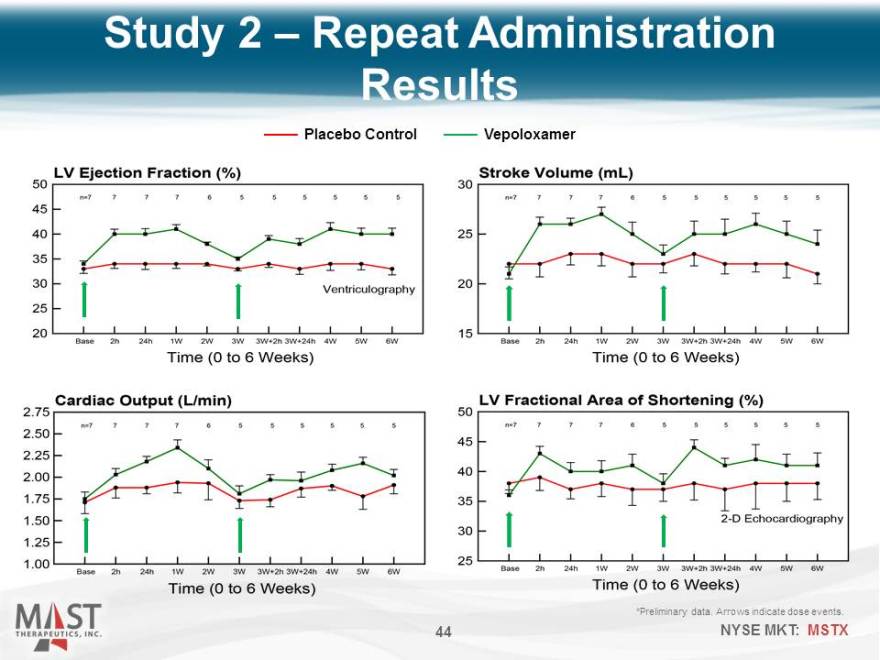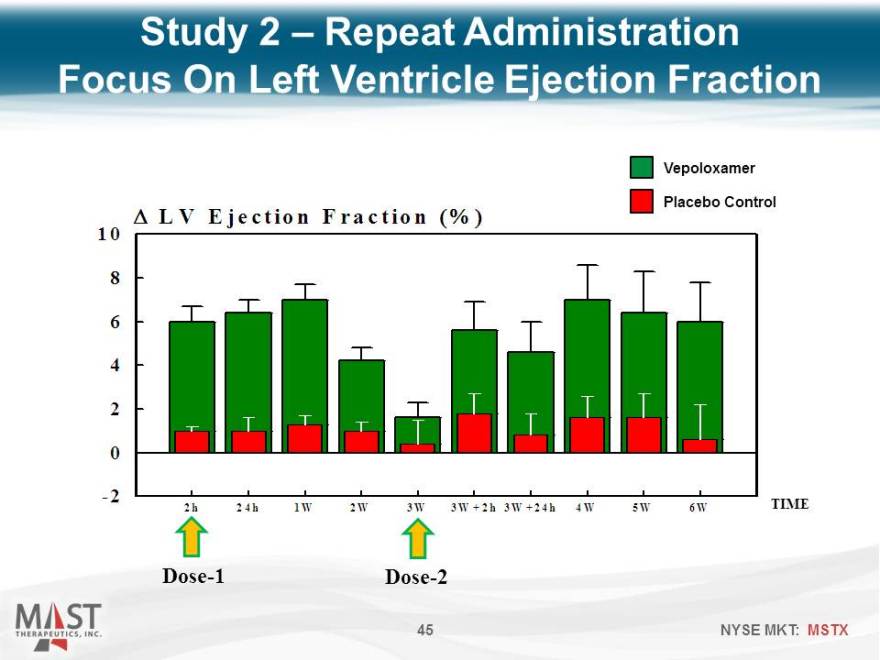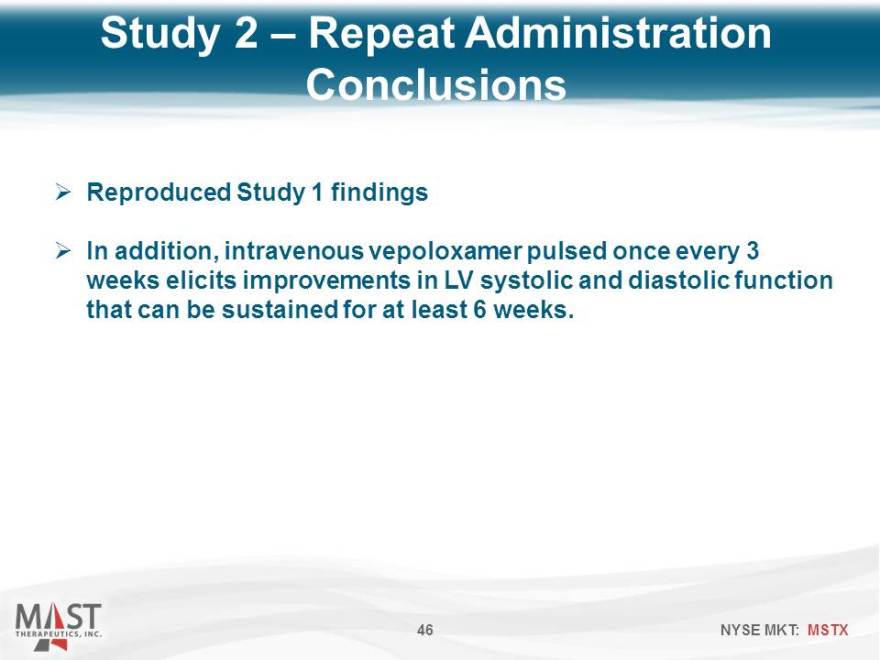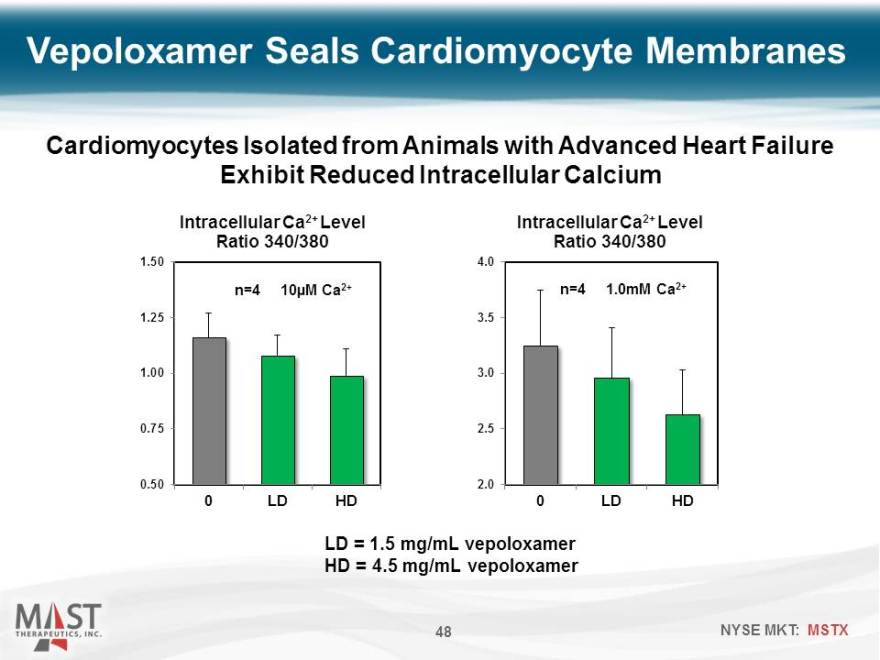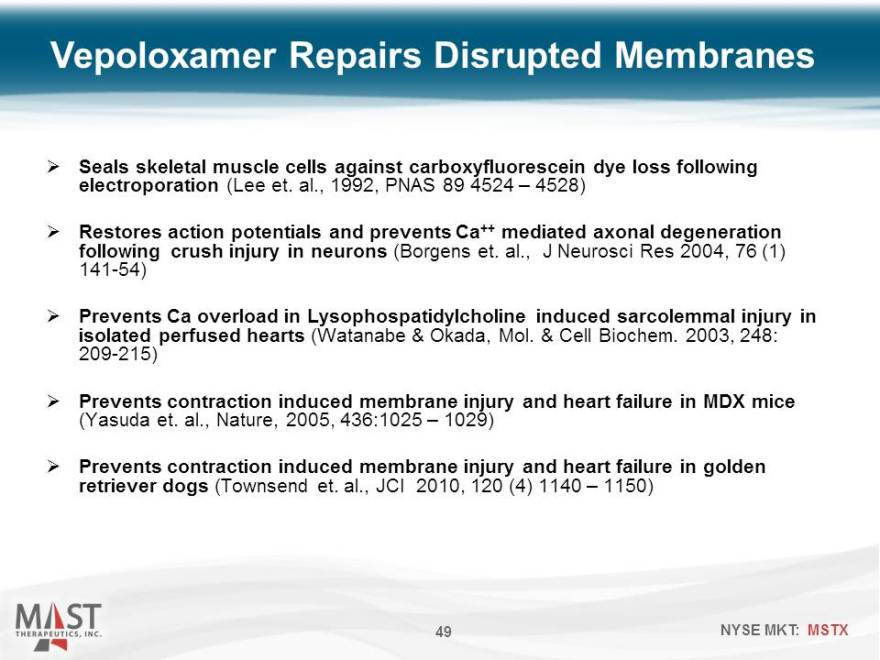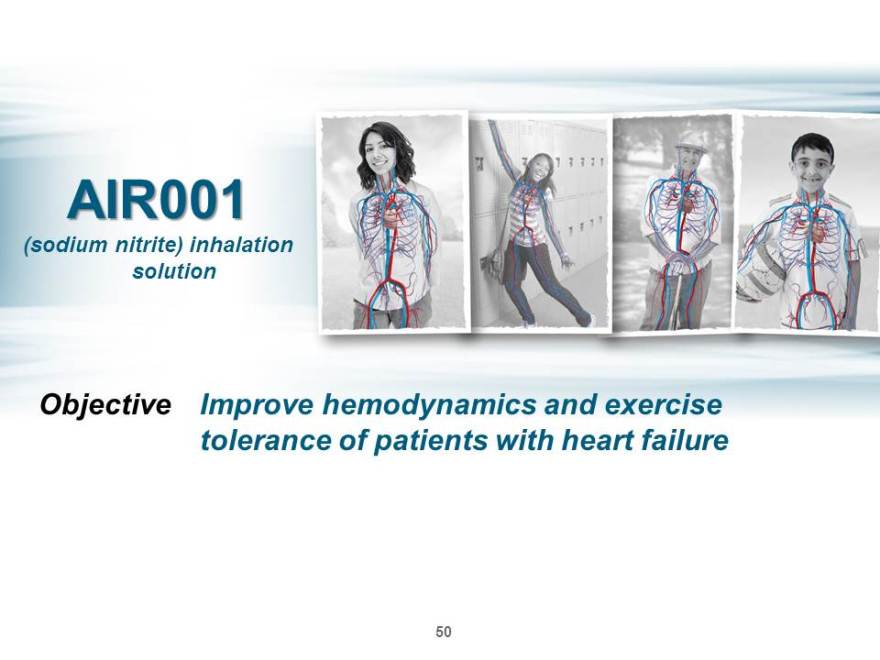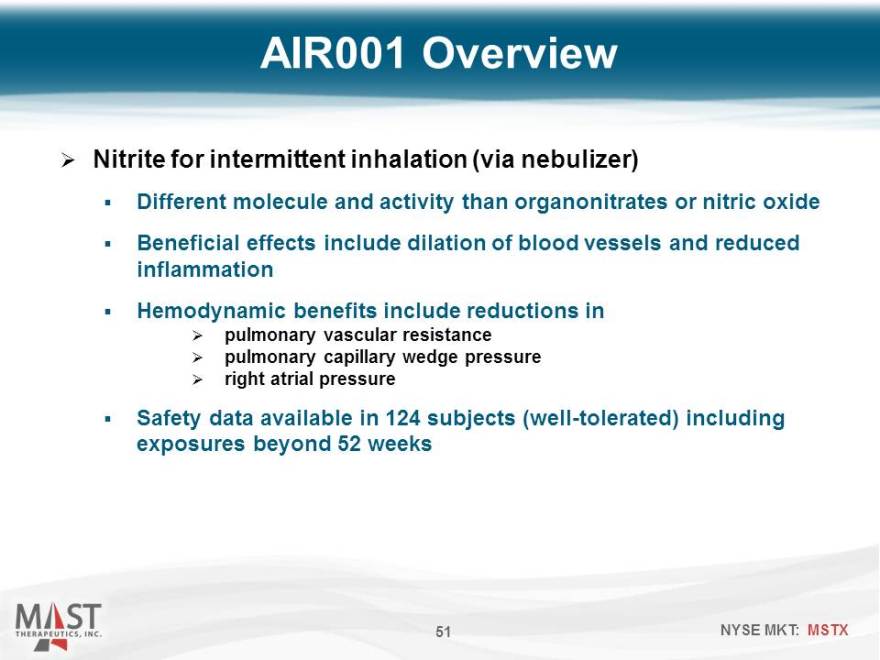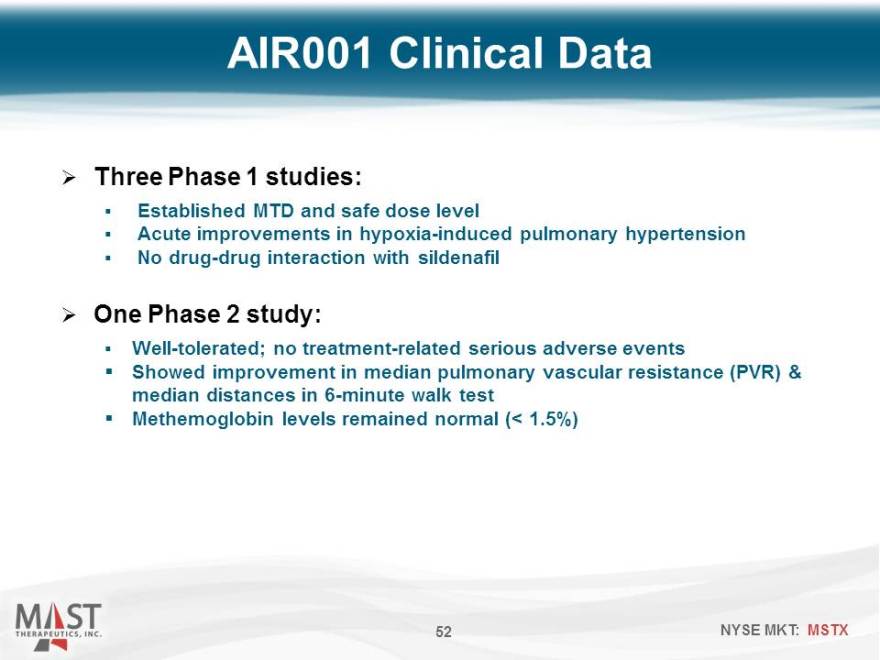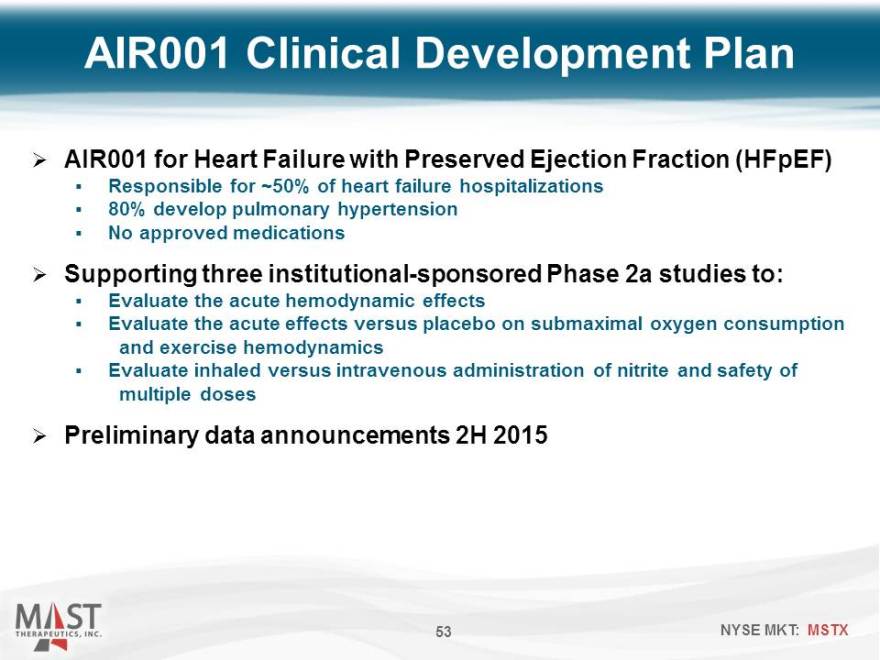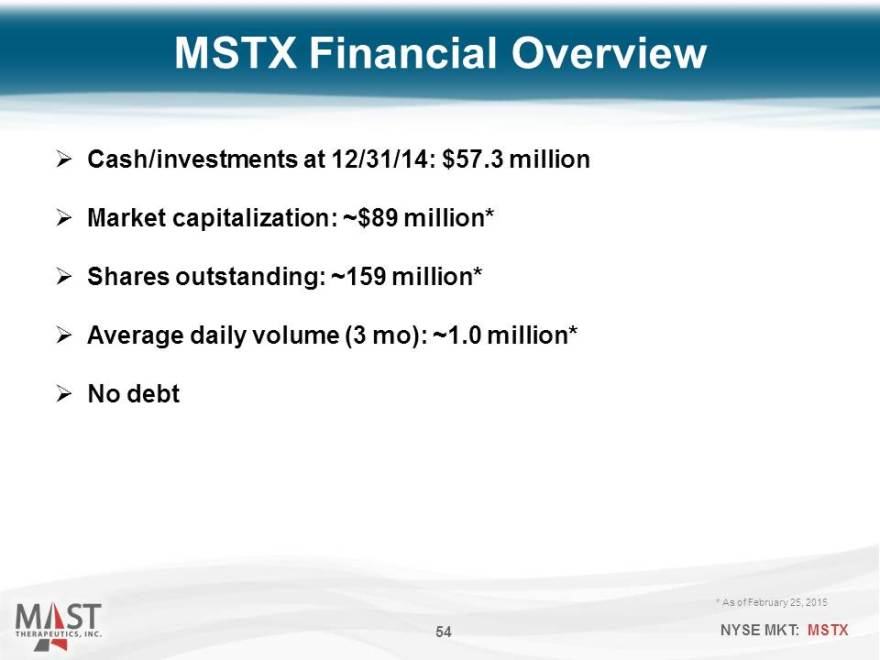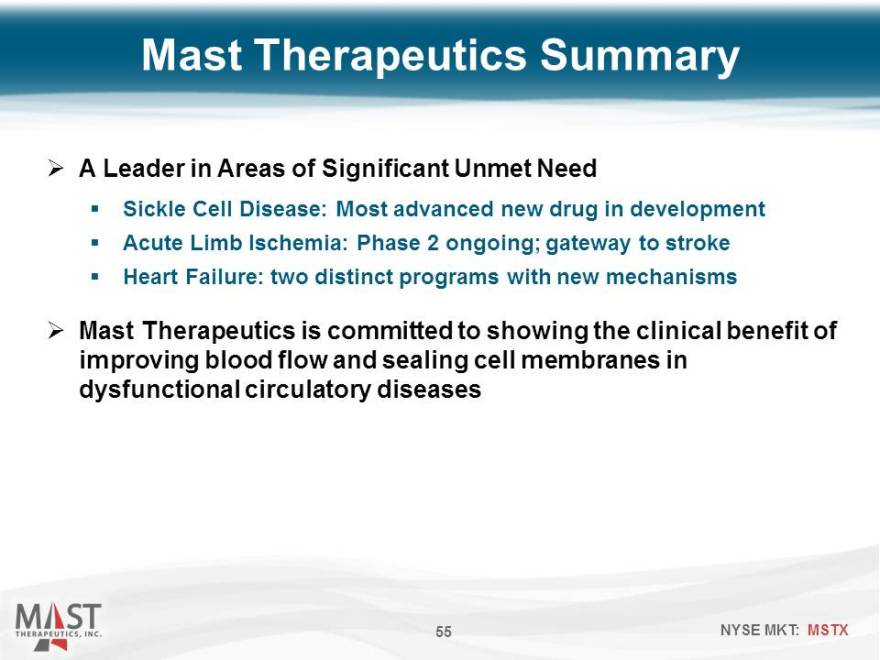|
Exhibit 99.1 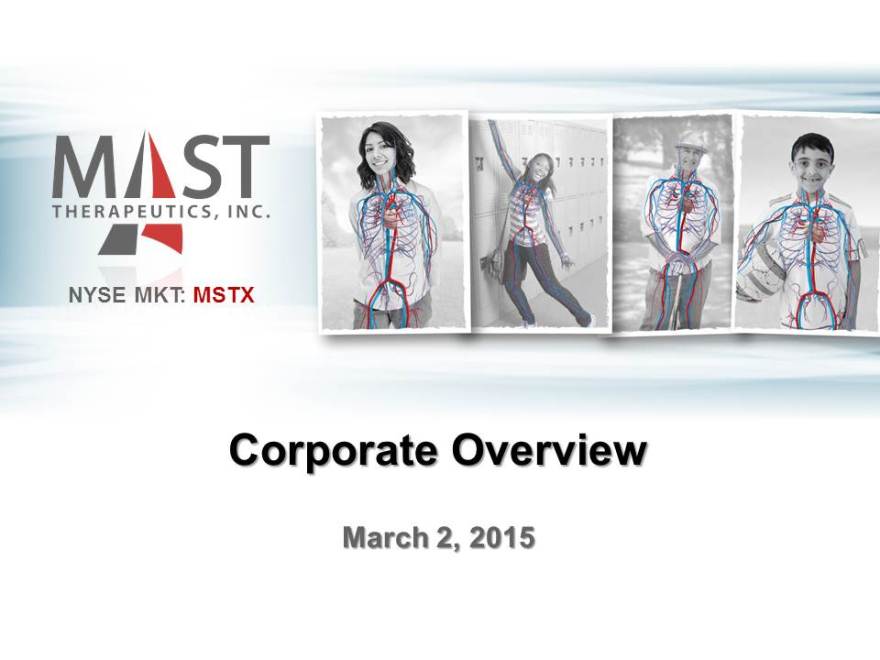
|
NYSE MKT: MSTX
Corporate Overview
March 2,, 2015
Forward-Looking Statements
This presentation includes forward-looking statements about our business prospects, financial position, and development of vepoloxamer and AIR001 for therapeutic use in humans. Any statement that is not a statement of historical fact should be considered a forward-looking statement. Because forward-looking statements relate to the future, they are subject to inherent risks, uncertainties and changes in circumstances that are difficult to predict. Actual events or performance may differ materially from our expectations indicated by these forward-looking statements due to a number of factors, including, but not limited to, results of our pending and future clinical studies, the timeline for clinical and manufacturing activities and regulatory approval; our dependency on third parties to conduct our clinical studies and manufacture our clinical trial material; our ability to raise additional capital, as needed; our ability to establish and protect proprietary rights related to our product candidates; and other risks and uncertainties more fully described in our press releases and our filings with the SEC, including our annual report on Form 10-K filed with the SEC on March 26, 2014.
We caution you not toplace undue reliance on any of these forward-looking statements, which speak only as of the date of this presentation. Wedonot intendtoupdate anyforward-looking statement included in this presentation to reflect events or circumstances arising after the date of the presentation, except as may be required by law.
2 NYSE MKT: MSTX
Corporate Overview
? Publicly-traded biopharmaceutical company based in San Diego
? Developing vepoloxamer (MST-188) for:
? Rare (“orphan”) diseases:
? Sickle Cell Disease ? Acute Limb Ischemia
? Large market opportunities:
? Heart Failure? Stroke
? Developing AIR001 for:
? Heart failure with preserved ejection fraction? Commercially complementary to vepoloxamer
3 NYSE MKT: MSTX
Product Candidate Pipeline
Vepoloxamer Preclinical Phase 1 Phase 2 Phase 3 Sickle Cell Disease
(orphan) Enrolling
Acute Limb Ischemia
(orphan) Enrolling
Heart Failure Planned
AIR001
Preclinical Phase 1 Phase 2 Phase 3
Enrolling
Heart Failure (“HFpEF”) Enrolling
Planned
4 NYSE MKT: MSTX
Lead Program
Vepoloxamer
Vepoloxamer: A Biophysical Agent
Poiseuille’s Law describes Newtonian flow
? Want lower viscosity?
? Reduce friction by lowering adhesion and improving the deformability of cells
? How?
? Reduce surface tension with vepoloxamer
Vepoloxamer Overview
HO – (CH2CH2O)79– (CH2CHO)30– (CH2CH2O)79– H
API Structure: | CH3
Large, synthesized polymer with extraction process to CMC: remove undesirable (toxic) components
Composition of matter claims pending Administration: IV infusion
Rapidly and predominantly cleared by kidneys (4-8h) ADME:
Ether linkages cannot be cleaved; no drug metabolites
7 NYSE MKT: MSTX
Vepoloxamer Mechanism of Action
Core of molecule adheres to hydrophobic domains on a cell surface, such as damaged membranes and adhesive proteins.
No Affinity for Healthy Cell Membranes…
But Adheres to Damaged Cell Membranes
Vepoloxamer Pharmacodynamics
Lowers adhesion Cell integrity maintained Improves flow Ca2+ influx reduced
Vepoloxamer adheres to hydrophobic domains on cells and lowers surface tensions
Intracellular Ca2+ Level
60
Ratio 340/380
50 4.0
Saline
CPS) 40 35 .
( Poloxamer 188
30
3.0
Viscosity 20
10 2.5
0 2.0
2.5 5 10 20 40 80 0 Low Dose High Dose
Shear Rate (1/sec)
9 NYSE MKT: MSTX
Vepoloxamer Pharmacodynamics
Vepoloxamer adheres to hydrophobic domains on cells and lowers surface tensions
Viscosity is reduced
Lowers adhesion
Improves flow Membranes are sealed
Cell integrity maintained
Ca2+ influx reduced Sickle Cell Disease: Less cell adhesion, reduced hemolysis
Acute Limb Ischemia: Faster thrombolysis, less reperfusion injury
Heart Failure: Lower viscosity, more membrane repair
10 NYSE MKT: MSTX
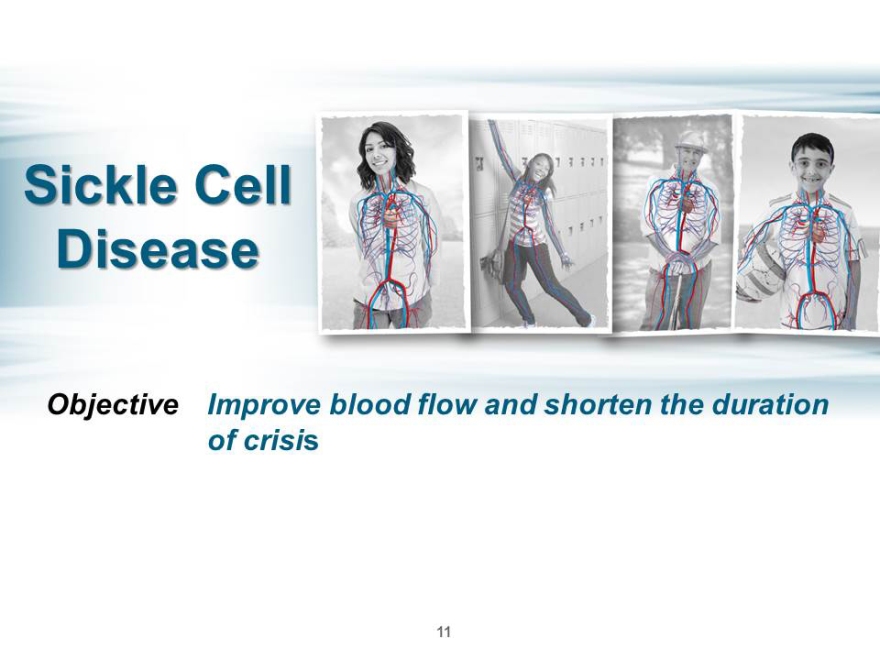
Sickle Cell Disease
Objective Improve blood flow and shorten the duration of crisis
11
Overview of Sickle Cell Disease
? A chronic, genetic disorder and rare (orphan) disease
? Affects 90,000 to 100,000 people in the US . .
? Characterized by severe deformation (i.e., “sickling”) of red blood cells
? Hallmark of disease is a “vaso-occlusive crisis”
? Exceedingly painful condition? Leading cause of hospitalization
? Significant unmet need
? No approved agents to shorten duration or severity of crisis
? Standard of care (hydration and analgesics) unchanged for >10 years
? Vaso-occlusion is associated with early death
? Obstructed blood flow -> hypoxia -> tissue death -> organ failure? Average age at death; 42 years (males), 48 years (females)
12 NYSE MKT: MSTX
Role of Vepoloxamer in Sickle Cell Disease
Vaso-Occlusive Crisis:
? Adhesion of poorly-deformable, “sticky” cells to endothelium and to each other leads to vessel obstruction? Occluded RBC’s cannot deliver oxygen, leading to ischemia, pain, organ damage
Vepoloxamer:
? Lowers viscosity, reduces adhesion of cells to endothelium, lowers RBC aggregation, improves RBC deformability and restores blood flow
13 NYSE MKT: MSTX
Vepoloxamer Reduces RBC Aggregation (normal volunteers)
Dose-dependent effect on red blood cell aggregation
1.2
1 gation Aggregate extent
0.8
Aggre 0.6 Aggregate strength
Relative 0.4 0.2
0
0.25 0.5 1 2 5 Poloxamer 188* (mg/mL)
? The effect of five concentrations of poloxamer 188* on RBC aggregation was determined using a Myrenne aggregometer.
? Results represent the mean of samples from 20 healthy volunteers relative to PBS controls. (Meiselman, et. al.)
*Vepoloxamer is purified poloxamer 188
14 NYSE MKT: MSTX
Vepoloxamer Reduces RBC Aggregation (sickle cell patients)
Dose-dependent effect on sickle cell red blood cell aggregation
1
Aggregate extent tion 0.8
Aggrega 0.6 Aggregate strength
0.4 lative 0.2 Re
0
0 0.25 0.5 1 Poloxamer 188* (mg/mL)
? The effect of poloxamer 188 on sickle cell RBC aggregation determined by a Myrenne aggregometer? Results represent the mean from 11 patients relative to PBS controls (Meiselman, et al.)
*Vepoloxamer is purified poloxamer 188
15 NYSE MKT: MSTX
Vepoloxamer Decreases Blood Viscosity Under Low Shear Rates
Poloxamer 188* decreased viscosity of sickle cell whole blood
Poloxamer 188 concentration (mg/mL)
? Poloxamer 188 added to whole blood (40% hematocrit) and viscosity measured using a Contraves viscometer at 3 shear rates.
? Results represent the mean of samples from 11 SCD patients relative to PBS controls. (Meiselman, et al.)
*Vepoloxamer is purified poloxamer 188
16 NYSE MKT: MSTX
Vepoloxamer Effect on Sickle Cells
Lower surface tension improves flow and deformability (video)
Before vepoloxamer After vepoloxamer
17 NYSE MKT: MSTX
Vepoloxamer Improves Blood Flow
Vepoloxamer improved microvascular blood flow in SCD patients during vaso-occlusive crisis
2.0
1.8 Vepoloxamer 1.6 Placebo
1.4 (p = 0.00003)
(mm/sec) 1.2 ty 1.0
0.8 Red cell velocity (mm/s) Veloci 0.6 measured by video microscopy in nine sickle cell patients with
0.4
02. vaso-occlusive crisis.
0
Before Infusion 2-Hours 7-Hours
(Crisis Baseline) After Loading After Loading
Source: J. Investig. Med. 2004;52(6):402-6
18 NYSE MKT: MSTX
Phase 2 Study
Randomized, double-blind, placebo-controlled, multi-center study in SCD patients hospitalized for vaso-occlusive crisis
Subjects Who Received Full Dose± Poloxamer 188* Placebo p value±±
(n=18) (n=13)
Duration of Crisis 44 hours 80 hours 0.025
Duration of Hospitalization 5 days 7 days 0.111 Total Analgesic Use 34mg 145mg 0.045 Parenteral Analgesic Use 27mg 133mg 0.022
± Excludes patients who had drug administration errors or incomplete pain assessments (16), who withdrew consent (2) and who withdrew because of injection site pain after 15 minutes of infusion. Subjects were excluded equally (n=9) between poloxamer 188 and placebo.
±± Proportional hazards model adjusted for baseline pain.
* Vepoloxamer is purified poloxamer 188
Source: Blood, September 1, 1997 – Vol 90, No. 5
19 NYSE MKT: MSTX
Acute Chest Syndrome Clinical Study
? Acute Chest Syndrome (ACS)
• Serious complication of SCD that results in prolonged hospitalizations
• A leading cause of death in SCD patients
? Vepoloxamer reduced duration of hospitalization in SCD patients with ACS compared to standard of care
Duration of Hospitalization (days)
14
12 12.8 Adults Children (>19y) (?19y)
10
9.9
8
7.9
6 7.2 6.3
4 4.1
2
0
NEJM 2000* Vepoloxamer? Vepoloxamer? NEJM 2000* Vepoloxamer? Vepoloxamer?
Standard of Lo Dose (40-80 Hi Dose (100-120 Standard of Lo Dose (40- Hi Dose (100-care mg/kg/hr) mg/kg/hr) care 80mg/kg/hr) 120mg/kg/hr) (n=128) (n=10) (n=4) (n=409) (n=20) (n=7)
*Source: NEJM, June 22, 2000, Vol 342, No 25 ? Data on file
20 NYSE MKT: MSTX
Prior Sponsor’s Phase 3 Study
ENROLLMENT? First large trial in sickle cell crisis ever
350 patients conducted (intended)
? Flawed endpoint selection and premature termination led to loss of power
255 patients
(actual)? Responder’s analysis highly informative:? All ages: 52% vs. 37% (n=249, p=0.02)? Under 16y*: 60% vs. 28% (n=73, p=0.009)
? Lessons learned for Mast Phase 3 study:? Vepoloxamer has activity in SCD
? Incorporate FDA, expert, and patient input? Use a clinically-relevant, objective endpoint? Anticipate and address data loss
*Average age of patients in Mast’s Phase 3 Source: JAMA, November 17, 2001 – Vol 286, No. 17
trial (EPIC) as of Jan 2015: 14 years 21 NYSE MKT: MSTX
Current Phase 3 Study “EPIC”
(Mast study)
? Double-Blind, Placebo-Controlled, Multicenter
? 388 patients, randomized 1:1 (standard of care +/- vepoloxamer)
? Primary Endpoint:
? Duration of crisis from randomization to last dose of parenteral opioid o Clinically relevant (no IV meds = readiness for discharge) o Sensitive data collection (patient-controlled analgesia device) o Reduction in data loss (PCA device)
? Secondary Endpoints and Other Assessments:
? Re-hospitalization for crisis within 14 days? Occurrence of acute chest syndrome? Duration of hospitalization? Biomarkers
? Power Calculations
? 90% power to detect a 16-hour difference (p=0.05), CV >50%? 85% power to detect a 24-hour difference (p=0.01), CV >50%
22 NYSE MKT: MSTX
EPIC Success Factors
? Enrollment on-track
? ~70 trial sites open (>50 in U.S.)? Top-line data anticipated Q1 2016
? Most Advanced New Drug in SCD
? Potential to be 1st drug ever approved to treat on-going vaso-occlusive crisis? Substantial head start versus other drugs in development
? Considerations for Regulatory Decision-Making
? Significant unmet need – standard of care unchanged for years? Increased reliance on disease experts in rare diseases? Support among medical / advocacy communities? Fast Track designation? Orphan Drug designation? Healthcare disparity concerns? Supportive studies: QT (complete) and repeat-administration (planned)
23 NYSE MKT: MSTX
Commercial Opportunity
United States
? Approximately 100,000 hospitalizations annually? ~50% of events occur in just 16 metropolitan areas? Effective coverage with small, targeted field force
Europe
? Approximately 40,000 patients? ~50% of patients reside in 2 cities:? Paris and London
24 NYSE MKT: MSTX
Arterial Disease
Vepoloxamer in Combination with Thrombolytics
? Acute Limb Ischemia? Stroke
Objective Accelerate time to thrombolysis and restore tissue perfusion
25
Overview of Arterial Disease
? A progressive circulatory problem in which obstructed arteries reduce blood flow to tissues
? Thrombolytic agents (tPA) are used to treat acute complications? Significant morbidity and mortality
Acute Ischemic Cerebrovascular Infarction
(stroke)
Acute Myocardial Infarction
(heart attack)
Peripheral Arterial Disease
? Intermittent Claudication? Critical Limb Ischemia? Acute Limb Ischemia
Development Strategy:? Develop initially in ALI? Expand into other markets
26 NYSE MKT: MSTX
Vepoloxamer is Antithrombotic
? Juvenile pigs were subjected to balloon angioplasty using excessive pressure and placement of a wire stent ? Animals were randomized to either heparin plus P188* (50 mg/kg as a bolus followed by a constant infusion of 25 mg/kg/hr) or a comparable volume of Heparin in normal saline (p < 0.01 Control vs P188).
Vepoloxamer is purified poloxamer 188 (P188)
27 NYSE MKT: MSTX
Accelerated tPA Activity Minutes Poloxamer 188 control (tpa) Time to Reperfusion Time to re-Occlusion
Animals subjected to femoral thrombotic occlusion randomized to tPA or tPA + poloxamer 188* (n=10), then monitored for blood flow Time to Reperfusion Time to Re-Occlusion Minutes Poloxamer 188 Control (tPA)
28 NYSE MKT: MSTX
Effect on Reperfusion Injury
Poloxamer 188* protected against no-reflow and reperfusion injury
40
36
35
ut )
30
Outp 25 normal 20 ac f 15 o
9
(% 10
Cardi 4.4
5 0
Blood Superoxide dismutase P188
? Rat hearts perfused with human packed red cells and heparin subjected to 90% ischemia followed by 10 min reperfusion.
*Vepoloxamer is purified poloxamer 188
29 NYSE MKT: MSTX
Synergy with Thrombolytics in Heart Attack Clinical Trial
p Value Parameter Poloxamer 188* Control Difference N=114
Myocardial
Infarct Size 16% 26% 38% reduction 0.031 (median) Myocardial Salvage (median) 13% 4% 125% increase 0.033
Ejection Fraction
13%
(median) 52% 46% 0.020 improvement
Incidence of
Reinfarction 1% 13% 92% reduction 0.016
*Vepoloxamer is purified poloxamer 188 Source: Circulation 1996; 94: 298-307
30 NYSE MKT: MSTX
Phase 2 Study in Acute Limb Ischemia
? Clinical Proof-of-Concept Study
? Biomarkers? Clinical outcomes
? Study Design
? Dose-finding, randomized, double-blind, and active-controlled? tPA +/- low or high dose vepoloxamer? 60 subjects (20 per arm)
? Timing
? Completion of enrollment anticipated 2H 2016
? Data can be supportive of clinical development in stroke
31 NYSE MKT: MSTX
Vepoloxamer in Stroke Model
Vepoloxamer alone or in combination with tPA improved neurological outcomes
? Vepoloxamer alone or in combination with tPA reduced neurological functional deficits following middle cerebral artery occlusion (MCAO) compared with animals treated with saline or tPA alone? Note: tPA administration occurred 4 hours following MCAO
Conducted by Michael Chopp, Ph.D. Henry Ford Health System
Data presented at 2015 International Stroke Conference
32 NYSE MKT: MSTX
Vepoloxamer in Stroke Model
Vepoloxamer alone or in combination with tPA reduced lesion volume
n = 10/group
? Panelsare H&E stained coronal sections obtained from representative rats treated with saline, vepoloxamer alone, tPA alone, and the combination of vepoloxamer and tPA following MCAO.
? Bar graph shows that treatments with vepoloxamer alone and in combination with tPA significantly reduced lesion volume compared to ischemic rats treated with saline and tPA monotherapy.
Conducted by Michael Chopp, Ph.D. Henry Ford Health System
Data presented at 2015 International Stroke Conference
33 NYSE MKT: MSTX
Heart Failure
(Chronic and Acute)
Objective Preserve heart cells and improve cardiac function
34
Overview of Heart Failure
? Chronic condition characterized by decreasing heart function
? Heart cannot pump enough blood to meet the body’s needs
? Primary clinical symptom is difficulty breathing (fluid in lungs – “congestive”)
? Significant Unmet Medical Need
? Leading healthcare cost in U.S. and Europe
? Substantial and Growing Market Opportunity
? > 5 million individuals with heart failure in the U.S.
? $21 billion of direct costs for heart failure in the U.S. in 2012
? Vepoloxamer
? Membrane-sealing activity may restore weakened cardiac cell membranes, minimizing calcium overload injury? Durable effect may indicate a direct improvement in cardiac function
35 NYSE MKT: MSTX
Background: Membrane Injury and Repair in Cardiomyocytes
? Membrane injury and repair is a constitutive event in healthy cells, especially those subjected to increased wall tensions from mechanical stress, such as cardiomyocytes.
? In healthy rat hearts, adrenergic stimulation increases myocyte wounding 3-fold.
? Frozen sections of normal rat heart were immunostained to reveal the distribution of serum albumin (wound marker). ? Quantitative image analysis indicated that an average of 25% of myocytes contained cytosolic serum albumin (i.e., had suffered a plasma membrane wound). Frequency increased approximately 3-fold after â-adrenergic stimulation (0.5ug/kg isoproterenol). *p<0.001 (Circ Res 1995;76:927-934 )
36 NYSE MKT: MSTX
Development Rationale in Heart Failure
? Elevated wall tension in a stressed heart impairs membrane repair, leading 0.25 to calcium influx and cardiac troponin 0.20
leak. (µm) n = 15 nt 0.15
? Vepoloxamer seals membranes and reduces surface tension, reducing 0.10
Displaceme n = 7
calcium damage and preserving cells.
ad 0.05
Be
? Vepoloxamer led to statistically 0.00 significant improvements in Control Poloxamer 188
(no treatment) (1.0 mg/mL)
hemodynamic parameters (LVEF, CO)
and biomarkers (troponin, NT-proBNP) in Effect of poloxamer 188* on cell surface tension (bead displacement) using membrane tethered model of heart failure. beads. Cells treated with 1.0 mg/mL poloxamer 188, had significantly reduced membrane tension.
*Vepoloxamer is purified poloxamer 188
37 NYSE MKT: MSTX
Chronic Heart Failure Model
Study 1: Single-administration
? The primary objective of this study was to examine the effects of acute intravenous administration of vepoloxamer on left ventricular (LV) systolic and diastolic function in dogs with advanced heart failure produced by intracoronary microembolizations
Conducted by Hani N. Sabbah, Ph.D., Henry Ford Health System Data presented at American Heart Society Scientific Sessions, November 2014
38 NYSE MKT: MSTX
Study 1 – Single Administration Protocol
21 Heart Failure Dogs (LV EF ~30%) Randomized
Low Dose High Dose Placebo – Control 2 hours infusion 2 hours infusion 2 hours infusion vepoloxamer vepoloxamer of normal saline (225 mg/kg) (450 mg/kg) (n=7) (n=7) (n=7)
FOLLOW-UP All Groups 24 hours
39 NYSE MKT: MSTX
Study 1 – Single Administration Results
2 | | Hours Post 24 Hours Post 1 Week Post 2 Weeks Post |
? LV Ejection Fraction (%) ? Stroke Volume (mL)
15 10
10 *
0 2 0 -5 -2
Control Low Dose High Dose Control Low Dose High Dose Vepoloxamer Vepoloxamer Vepoloxamer Vepoloxamer
? nt-pro BNP (pg/mL) ? Plasma Troponin-I (ng/mL)
500 0.1 300 100 00. -100 -300 -0.1
-500 * * -700 -0.2 -900 * -1100 * -0.3 * * *
Control Low Dose High Dose Control Low Dose High Dose Vepoloxamer Vepoloxamer Vepoloxamer Vepoloxamer
40 NYSE MKT: MSTX
Study 1: Single Administration Conclusions
? Intravenous vepoloxamer elicits improvements in LV systolic and diastolic function that lasts for at least one week after end of drug infusion
? The functional improvement is supported by significant reductions of NT-proBNP for up to 2 weeks
? The decline in plasma troponin-I level suggest that vepoloxamer may act to limit ongoing cardiomyocyte loss by limiting unregulated calcium entry into the cell and thus limiting calcium overload
41 NYSE MKT: MSTX
Chronic Heart Failure Model
Study 2: Repeat-administration
? The primary objective of this study was to examine the effects of acute intravenous administration of multiple doses of vepoloxamer on left ventricular (LV) systolic and diastolic function in dogs with advanced heart failure produced by intracoronary microembolizations
Conducted by Hani N. Sabbah, Ph.D. Henry Ford Health System
42 NYSE MKT: MSTX
Study 2 – Repeat Administration Protocol
14 Heart Failure Dogs (LV EF ~30%) Randomized
Placebo – Control High Dose 2 hours infusion 2 hours infusion of normal saline vepoloxamer (450 mg/kg) on week 0 and on week 0 and week 3 week 3 (n=7) (n=7)
Total Follow-Up All Groups
43 NYSE MKT: MSTX
Study 2 – Repeat Administration Results
Placebo Control Vepoloxamer
*Preliminary data. Arrows indicate dose events.
44 NYSE MKT: MSTX
Study 2 – Repeat Administration Focus On Left Ventricle Ejection Fraction
Vepoloxamer
Placebo Control
10??L V E je c tio n F r a c tio n????
-2
2h 2 4 h 1 W 2 W 3 W 3 W + 2 h 3 W + 2 4h 4W 5W 6 W TIME
Dose-1 Dose-2
45 NYSE MKT: MSTX
Study 2 – Repeat Administration Conclusions
? Reproduced Study 1 findings
? In addition, intravenous vepoloxamer pulsed once every 3 weeks elicits improvements in LV systolic and diastolic function that can be sustained for at least 6 weeks.
46 NYSE MKT: MSTX
Study 2 – Repeat Administration Supplemental Findings
Sealing membranes with vepoloxamer
? Protocol: Isolated cardiomyocytes were treated with vepoloxamer at room temperature for 2 hours
? Cells were then washed and treated with 10 uM Fura-2 AM dye for 1 hour ? Excess dye was then washed out and cells were resuspended in EDTA (calcium chelator) or 0.5 mM calcium chloride and flourescence intensity readings were obtained after 2 hours at 340/510 and 380/510 ? Calcium level (based on florescence levels) within the cell was calculated as the ratio of 340/380
Conducted by Hani N. Sabbah, Ph.D. Henry Ford Health System
47 NYSE MKT: MSTX
Vepoloxamer Seals Cardiomyocyte Membranes
Cardiomyocytes Isolated from Animals with Advanced Heart Failure Exhibit Reduced Intracellular Calcium
Intracellular Ca2+ Level Intracellular Ca2+ Level Ratio 340/380 Ratio 340/380
1.50 4.0
n=4 10µM Ca2+ n=4 1.0mM Ca2+
1.25 3.5 1.00 3.0 0.75 2.5
0.50 2.0
0 LD HD 0 LD HD
LD = 1.5 mg/mL vepoloxamer HD = 4.5 mg/mL vepoloxamer
48 NYSE MKT: MSTX
Vepoloxamer Repairs Disrupted Membranes
? Seals skeletal muscle cells against carboxyfluorescein dye loss following electroporation (Lee et. al., 1992, PNAS 89 4524 – 4528)
? Restores action potentials and prevents Ca++ mediated axonal degeneration following crush injury in neurons (Borgens et. al., J Neurosci Res 2004, 76 (1) 141-54)
? Prevents Ca overload in Lysophospatidylcholine induced sarcolemmal injury in isolated perfused hearts (Watanabe & Okada, Mol. & Cell Biochem. 2003, 248: 209-215)
? Prevents contraction induced membrane injury and heart failure in MDX mice
(Yasuda et. al., Nature, 2005, 436:1025 – 1029)
? Prevents contraction induced membrane injury and heart failure in golden retriever dogs (Townsend et. al., JCI 2010, 120 (4) 1140 – 1150)
49 NYSE MKT: MSTX
AIR001
(sodium nitrite) inhalation solution
Objective Improve hemodynamics and exercise tolerance of patients with heart failure
50
AIR001 Overview
? Nitrite for intermittent inhalation (via nebulizer)
? Different molecule and activity than organonitrates or nitric oxide? Beneficial effects include dilation of blood vessels and reduced inflammation? Hemodynamic benefits include reductions in
? pulmonary vascular resistance? pulmonary capillary wedge pressure ? right atrial pressure
? Safety data available in 124 subjects (well-tolerated) including exposures beyond 52 weeks
51 NYSE MKT: MSTX
AIR001 Clinical Data
? Three Phase 1 studies:
? Established MTD and safe dose level
? Acute improvements in hypoxia-induced pulmonary hypertension? No drug-drug interaction with sildenafil
? One Phase 2 study:
? Well-tolerated; no treatment-related serious adverse events
? Showed improvement in median pulmonary vascular resistance (PVR) & median distances in 6-minute walk test? Methemoglobin levels remained normal (< 1.5%)
52 NYSE MKT: MSTX
AIR001 Clinical Development Plan
? AIR001 for Heart Failure with Preserved Ejection Fraction (HFpEF)
? Responsible for ~50% of heart failure hospitalizations? 80% develop pulmonary hypertension? No approved medications
? Supporting three institutional-sponsored Phase 2a studies to:
? Evaluate the acute hemodynamic effects
? Evaluate the acute effects versus placebo on submaximal oxygen consumption and exercise hemodynamics? Evaluate inhaled versus intravenous administration of nitrite and safety of multiple doses
? Preliminary data announcements 2H 2015
53 NYSE MKT: MSTX
MSTX Financial Overview
? Cash/investments at 12/31/14: $57.3 million? Market capitalization: ~$89 million*? Shares outstanding: ~159 million*? Average daily volume (3 mo): ~1.0 million*? No debt
* As of February 25, 2015
54 NYSE MKT: MSTX
Mast Therapeutics Summary
? A Leader in Areas of Significant Unmet Need
? Sickle Cell Disease: Most advanced new drug in development? Acute Limb Ischemia: Phase 2 ongoing; gateway to stroke? Heart Failure: two distinct programs with new mechanisms
? Mast Therapeutics is committed to showing the clinical benefit of improving blood flow and sealing cell membranes in dysfunctional circulatory diseases
55 NYSE MKT: MSTX

